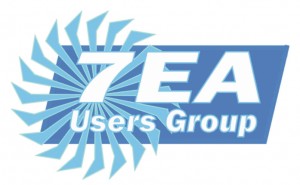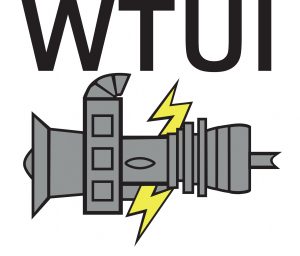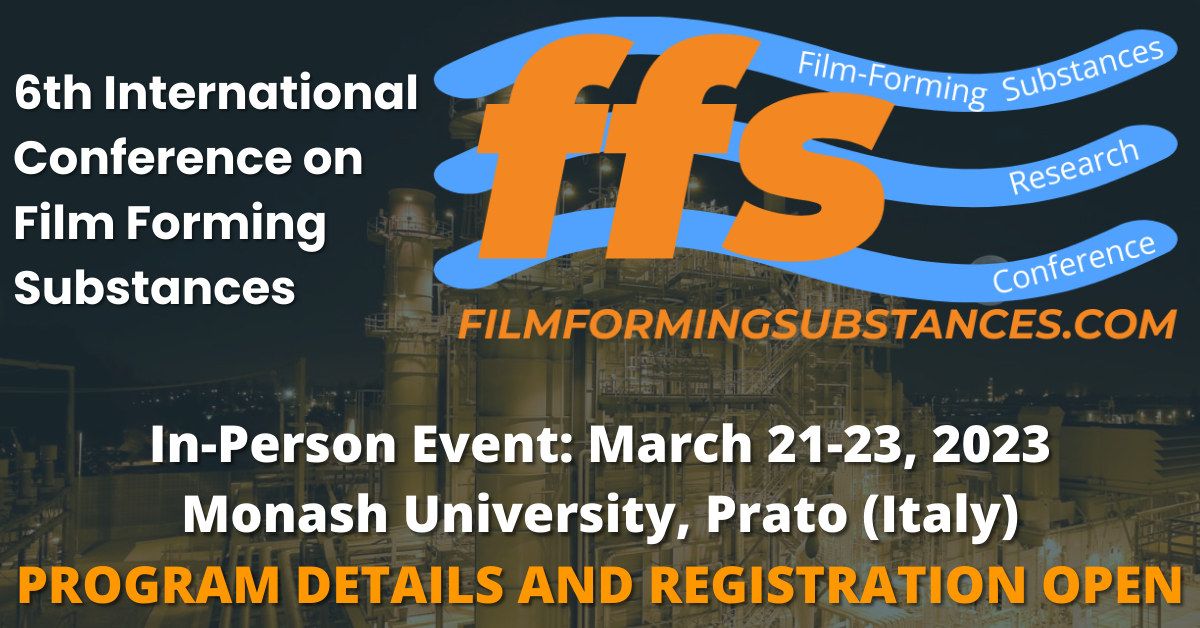The Legacy Turbine Users Group, formed by Power Users earlier this year to facilitate the transfer of knowledge among members of the 7EA and Frame 5 and 6B users groups, greatly benefits owner/operators of these engines. The 7EA’s first meeting under the LTUG banner, conducted Aug 29 – Sept 1, 2022, was an unqualified success and will be reviewed in an upcoming issue.
Here the editors present the highlights of the 2021 7EA conference, which you may have missed because of the pandemic, and salute the staffs of the Lincoln Generating Facility and Crete Energy Venture, both powered by 7EAs, for their success in CCJ’s Best Practices Awards program. The presentations reviewed below are available user access through the conference archives at www.powerusers.org.
The 7EA Users Group has been serving owner/operators of GE Model 7EA, A, B, C, and E gas turbines for more than a quarter of a century. Today, the OEM refers to this group of units collectively as 7E, a naming convention which can be confusing to some plant personnel.
A bit of history. The first two Frame 7 package power plants (PPP)—the lingo used by GE decades ago for its gas turbine/generators “packaged” for rapid deployment where power was needed—were ordered by Long Island Lighting Co and installed in the summer of 1971—one at the utility’s West Babylon plant, the other at its Shoreham Plant (a/k/a Wading River).
The nominal 52-MW distillate-fired units were still in standby service and equipped with their original Mark I Speedtronic™ control systems when the editors contacted National Grid, the current asset owner, last year.
Today, there are roughly 1200 7Es (new GE designation) in service worldwide—three-quarters of them are 7EAs.
7EAUG Steering committee, 2022
Dale Anderson, East Kentucky Power Co-op
Joshua Coots, Duke Energy
Tracy Dreymala, EthosEnergy Group, San Jacinto Peakers
Jeff Hansen, Old Dominion Electric Co-op
Guy LeBlanc, IHI Power Services Corp
Tony Ostlund, Puget Sound Energy
Mike Vonallmen, Clarksdale Public Utilities
Lane Watson, FM Global Chemical Operations
User presentations
Lessons from the field: Circuit-breaker maintenance practices
Breaker events profiled in this slide deck, available to registered users at www.powerusers.org include the following:
- New breaker failure at a 7E simple-cycle plant.
- Vacuum-bottle failure at a hydro plant.
- Catastrophic breaker overheating.
- Single-pole failure of a 115-kV breaker.
The takeaways from these events provide valuable “lessons learned.” For the first, the presenters’ experience confirmed that modern relaying can be of considerable help in speeding-up troubleshooting after an electrical trip. The second showed vacuum bottles have a finite life. More specifically, dc hipot/bottle integrity tests do not give an indication of future life.
Takeaway from No. 3, illustrated with circuit and logic diagrams, and photos of damage: Breaker forced-cooling apparatus is important if it’s applied. Action items: Act on alarms, check runback levels, maintain cooling fans, and correct failing switches. Important: Spare breakers can be a life-saver.
High-side/substation breaker reliability is critical, attendees were told. Ensure the plant, or transmission utility, is providing proper maintenance and upgrades. Review your Generation Interconnection Agreement regarding responsibilities—if your plant has one. In any case, proper and regular maintenance must be performed on all components to ensure reliability.
Guidance on the maintenance required is provided, along with the timing of tests, what good results look like, and data interpretation. Bear in mind that roughly half of all breaker performance failures are attributed to lubricant degradation, improper selection, and/or misapplication.
A lunch-and-learn session in the plant break room might be in order to familiarize staff with breaker assembly and components, troubleshooting, spare parts, the importance of proper bolt torquing, and where to find the breaker manuals when they’re needed.
In-situ fuel-nozzle flow testing
Presenters describe positive results in using a portable air-flow test stand (PATS), a/k/a portable flow bench, to conduct fuel-nozzle testing in-situ rather than removing fuel nozzles from the gas turbine and sending them to a shop for that purpose. Important point: This owner has a fleet of well over a hundred gas turbines.
The PATS was said to provide a direct measurement of the engine’s fuel-nozzle characteristics, with the ability to isolate the problem to a single combustor position/circuit and possibly eliminating fuel-nozzle flow as a cause of the issue being dealt with. Several slides describe how PATS works and the infrastructure support required to conduct testing—for example, more than 80 cfm of clean, dry air.
Case studies are summarized for the following engines:
- 501FD2 (DLN)—high blade-path spreads, with cold spot.
- 7F (DLN 2.6)—high exhaust spreads after an outage, with cold spot.
- 7EA—high exhaust spreads after a liquid-fuel run, with cold spot.
- 7EA (DLN 1)—high exhaust spreads after an outage, with no hot/cold spot.
In closing, the speakers shared what challenges colleagues might encounter with in-situ flow testing, including these:
- Access to air of the quantity and quality required.
- Possible limitations of PATS given ambient-air characteristics where used (not a controlled repair-shop environment).
- Not all combustion issues can be solved with flow testing.
- Easier when fuel-nozzle flow targets are available to compare to “spec.”
Vendor presentations
What we are seeing in the 7EA fleet during our inspections
Advanced Turbine Support
The 2021 version of this annual presentation by Mike Hoogsteden, the company’s director of field services, which is of significant value to plant personnel for its many illustrations, highlighted GE Technical Information Letters (TIL) users should become familiar with, in particular—including the following:
- TIL-1854, “Compressor Rotor Stages 2 and 3 Tip Loss,” suggests blending and tipping to mitigate the impact on availability and reliability of Row 2 and/or R3 tip loss.
- TIL-1884, “7EA R1/S1 Inspection Recommendations,” addresses the need to inspect R1 and S1 airfoils for possible damage caused by clashing—the unwanted contact between the leading edges of S1 stator-vane tips and the trailing edges of rotor blades in the platform area.
- TIL-1980, “7EA S1 Suction Side Inspection Recommendations,” advises users to inspect for crack indications on S1 vanes made of Type-403 stainless steel, regardless of whether clashing damage is in evidence on S1 and R1 airfoils or not.
- TIL1562-R1, “Heavy-Duty Gas Turbine Shim Migration and Loss,” informs users on the need to monitor the condition of compressor shims and correction actions available to mitigate the risks of migrating shims.
Compressor stator-vane looseness: What to look for and what to do
CTTS (a/k/a Core Tech)
Pinning is a relatively low-cost and quick solution for gas-turbine owner/operators challenged by compressor stator-vane looseness. More than 200 engines have been “pinned” in the last 20 years, avoiding engine damage and saving thousands of vanes (Fig 1).
The pinning technique, developed by Rodger Anderson, who began his career as a member of GE Frame 7 compressor design team, has been the subject of several CCJ articles over the years. What to look for during your next compressor inspection in terms of shim migration and vane looseness/damage is described in the slide deck along with the likely causes.
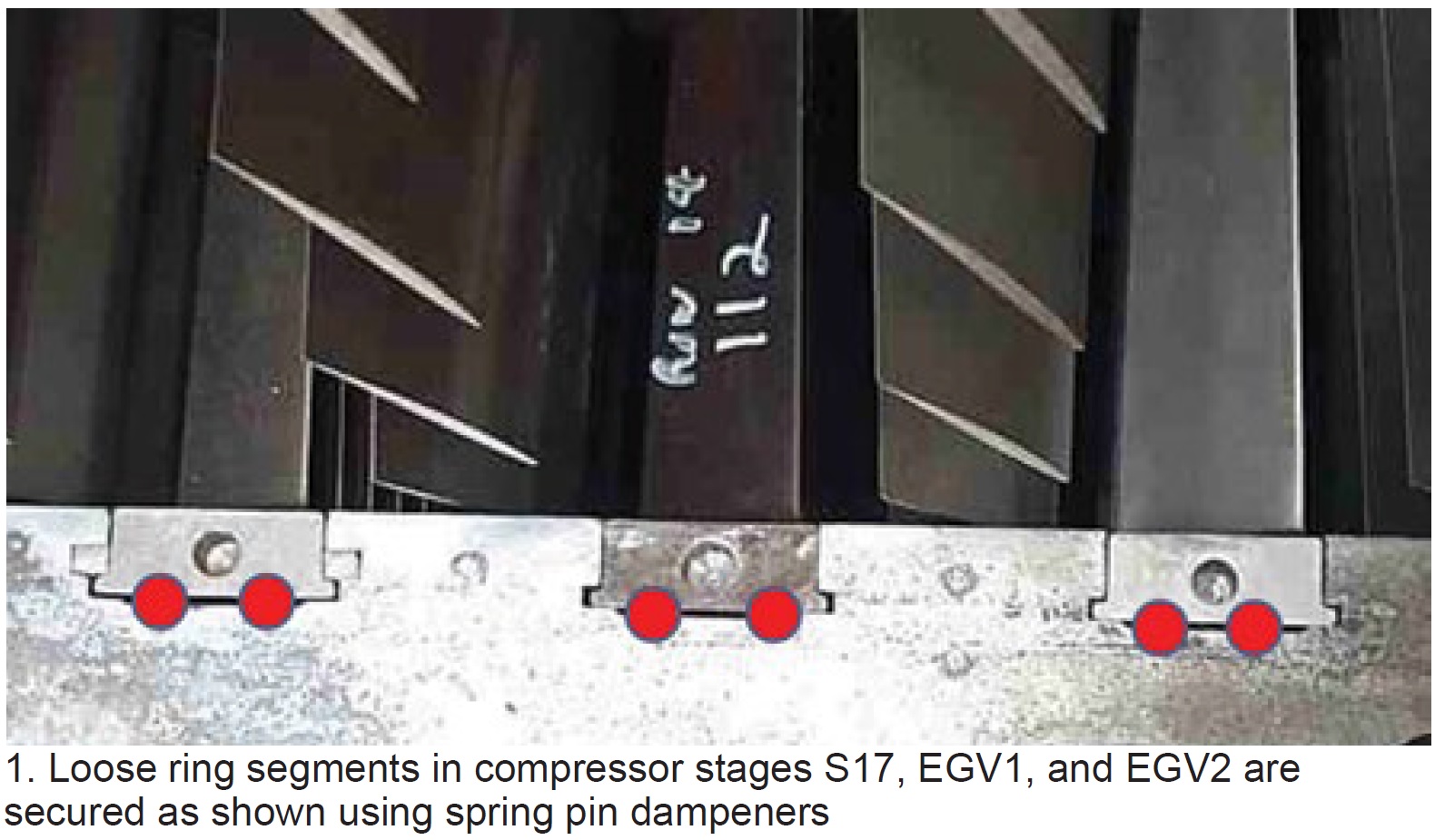
Emergency rotor support services—a case study
Sulzer
The borescope inspection of a simple-cycle 7F unit revealed severe damage in compressor rows 14 through the exit guide vanes (Fig 2 left). The owner/operator needed the unit back in service ASAP. Presentation slides detail the steps taken to assure proper corrective action—from inspection to rotor disassembly to parts replacement with shop-manufactured components to reassembly (Fig 2 right) to rotor balancing to preparation for shipment to the plant—in only 36 days.
Details presented in the slides provide a valuable learning experience for the plant team. The second part of the presentation gives details on Sulzer’s capabilities, repair history, shop capabilities, rotor life assessments, and field services.
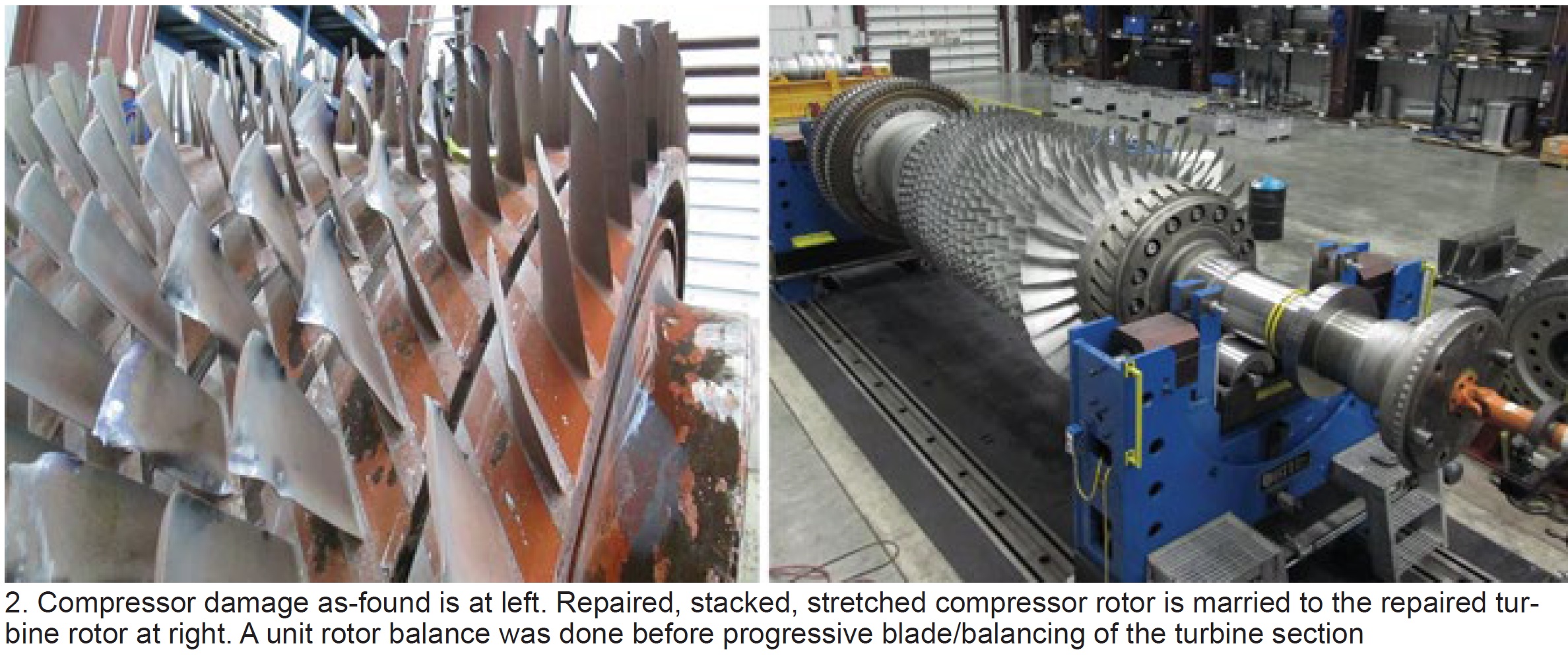
Analysis of inspection protocols for S-1/R-1 clashing
Veracity Technology Solutions
The goal of an inspection protocol should be to provide the highest sensitivity for flaw detection and determine an inspection frequency that gives the inspector the most opportunities to detect a flaw before the defect becomes catastrophic.
In the example given, two units were undergoing their annual NDE inspections to satisfy the requirements of TIL-1884 (see first item above). The units were equipped with C450 stators, which exhibited signs of corrosion lockup in the lower half after nearly 11,000 fired hours and 2000 starts. An eddy-current inspection was specified; a fluorescent penetration inspection was conducted as well to validate the findings.
Many indications were identified and are shown in the slides. Analysis revealed the cracks emanated from shallow surface discontinuities which experts believe were caused by one or more of the following: environmental conditions, possible stress corrosion cracking, and high-cycle fatigue (from stator lockup in the vane carrier).
Conclusions: The use of traditional penetrant methods may not be effective for detecting the types of cracks found. Only after the stators were removed and sent to the shop did the inspection team identify all of the flaws using its proprietary inspection technique.
It’s important to note that swapping out of the Type-C403 stainless-steel stators installed on older machines with C450 components recommended by the OEM may not provide the level of asset protection desired. The bottom line: It’s imperative to be diligent on your inspection protocol.
Getting your 7EA ready for increased run time
Emerson
If you’re looking for a checklist of action items to improve the run times of your units, reading through this presentation is a good place to start. It focuses on controls mods, generally far less costly than hardware changes, to consider. Example: Control mods can enable the transition from normal to fast starts (Fig 3).
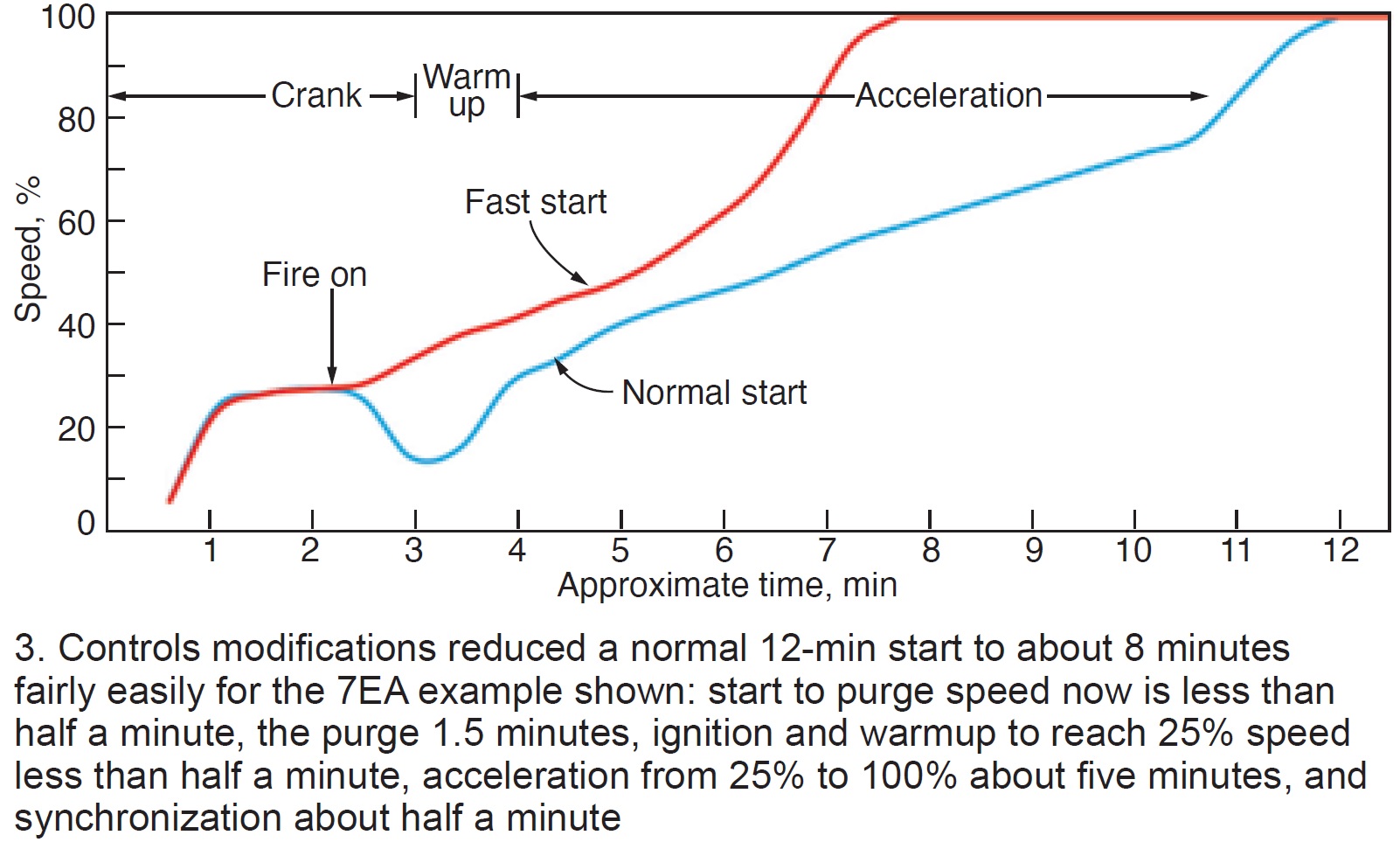
Bus maintenance in action
RMS Energy
Bus duct is relatively easy to maintain. Keep it dry, clean, and cool, the RMS Energy experts say, and your problems will be minimal. But how many plant personnel do you see walking around outside and looking up? And even if they were, the upper portion of the duct remains out of sight.
The presentation begins with a list of critical bus-duct components: Flex/bolted connections (current carrying), expansion bellows/joints, insulators and mountings, seal-off bushings, grounding, and insulated joints. Fig 4 shows some of the damage one can expect without a rigorous monitoring/inspection plan.
Monitoring equipment/techniques suggested include these: Thermocouples and infra-view camera to monitor components remotely and initiate alarms. Electromagnetic signature analysis (EMSA) is a valuable online diagnostic technology that can support maintenance decisions based on real-time operating conditions. It can save critical shutdown time by eliminating the need for offline testing.
Several case studies with before/after photos are instructive.
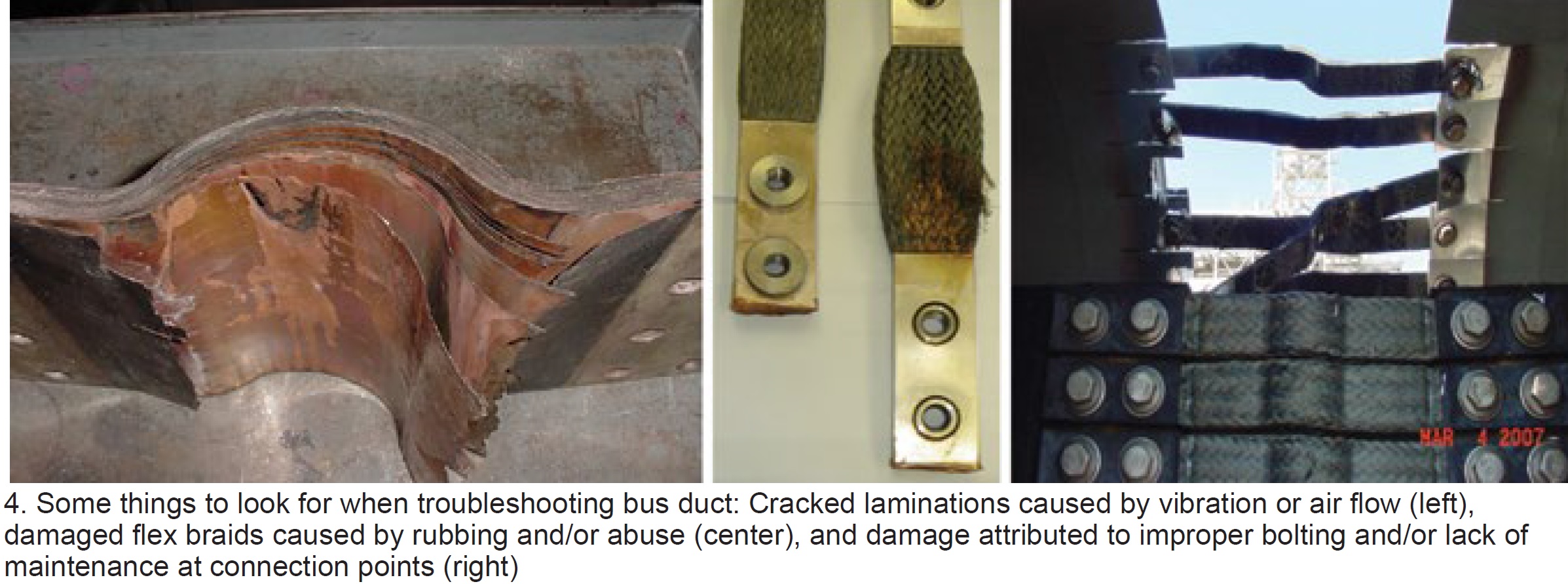
The GTC quick solutions package
GTC Control Solutions
Five case studies encompass this presentation; four are explained below.
The first describes a single point of failure. Problem: A high differential among ambient-temperature thermocouples (t/cs) was causing a “not ready to start” situation. There were two compounding issues: The first was sub-optimal location of the t/cs. This second: A “no high differential” was a start permissive—that is, a high differential would result in a “not ready to start” condition.
The fix: Two t/cs were relocated to prevent erroneous temperature measurements. Plus, the “no high differential logic” as a permissive to start was changed to “two out of three t/cs failed.” The latter assures that if one t/c fails, operators receive an alarm but will still remain ready to start; two failed t/cs interrupt the start sequence.
Case 2 involved an LM5000, which has two speed pick-ups per shaft. Originally, the “Hi-Select” determined speed. Thus, one failed hi-detector trips the unit. Solution was to check inputs and reject “out-of-limit” values.
Case 3 involved an LM2500 with very hot starts. Over-temperature trips occurred during startups. Diagnostic alarms indicated a loss of P2 pressure feedback. Solution was a logic change to “IF on temperature control during startup THEN trip.”
Case 4 described problems with a 7B gas turbine equipped with torque converter, jaw clutch, and limit switch that experienced starting difficulty. Clutch disengaged at 47% speed; however, logic required clutch to remain engaged until 50% speed. Torque converter degradation was the problem and the logic was changed to permit clutch disengagement below 50% speed.
Gas-turbine operability challenges in an unstable grid environment
EthosEnergy
Chris Chandler, chief technologist for turbine optimization, warned attendees that recent grid-wide reliability events in California (summer 2020 ) and Texas (calamitous winter freeze 2021) were likely to be experienced nationwide as the percentage of renewables on grids keeps growing. Because gas turbines and combined cycles will be expected to “pick up the megawatt slack” when renewables output drops by hundreds, and even thousands, of megawatts precipitously, combined cycles need to adapt for operation at the “lowest sustainable limit” (LSL).
Balance of Chandler’s presentation explains how the company’s Ecomax Extended Turndown optimization package can extend the life of the equipment while operating more hours at LSL. It addresses the consequences of operating at prolonged maximum turndown states, most importantly the inability of the HRSG to adequately attemperate and higher CO production from the combustor.
Operators are alerted in real time what the LSL is and the Ecomax Extended Turndown “knobs” are used to operate at that point until CO becomes an issue. The system can boost GT output by 5 to 15 MW per unit at the low end, says Chandler. As of this presentation last year, the concepts had been validated and the program was in commercial development with a lead user.
7EA turndown solutions: How low can we go?
PSM
Presentation is a good review of PSM’s tools for extending engine turndown. It begins with a review of the company’s LEC-III™ ultra-low emissions and LEC-NextGen combustion systems and refreshes your recollection of its inlet bleed heat and exhaust bleed solutions.
PSM’s latest turndown solution—Sequential Fuel Injection (SFI)—specifically engineered for 7E (that is, Models 7B through 7EA) LEC and DLN 1 combustion systems is the presentation’s focus. SFI is said to leverage prior sequential combustion experience with the company’s FlameSheet™ product, to achieve comparable results with SFI without major changes to existing combustion hardware (Fig 5).
Recall that low-emission combustors are sized for optimum NOx emissions at baseload and “lean-out” as load is reduced; CO spikes as the Minimum Emissions Compliant Load (MECL) is approached. With SFI, the main/head-end combustor is sized for CO at MECL, and SFI fuel is added proportionally as load is increased from MECL to baseload (up to 15% of the total).
SFI fuel reacts with hot excess air from the main/head-end combustor, holding the temperature rise in check, thereby minimizing NOx production while also maintaining low CO.

Remote operations for simple-cycle GT sites
Emerson
Lots of things to think about if your simple-cycle unit is not yet equipped for remote operation. Presentation’s stated goal is to help users leverage digital transformation to save O&M and increase earnings.
Using flow net modeling to optimize fuel-nozzle calibration and flow testing
Trinity Turbine Technology
New ideas for optimizing combustion-system air and gas mixing to reduce emissions and temperature spreads. Results have been promising; work continues.
Emergency material and design support
Schock Manufacturing
Slide deck focuses on Schock Manufacturing’s ability to respond quickly to customer problems—such as expansion-joint blowout, exhaust-liner sheet failure, diverter damper seat and landing-bar failures, failed trash screens, stack corrosion, failure of silencer panels, etc (Fig 6). Customer testimonials are included.
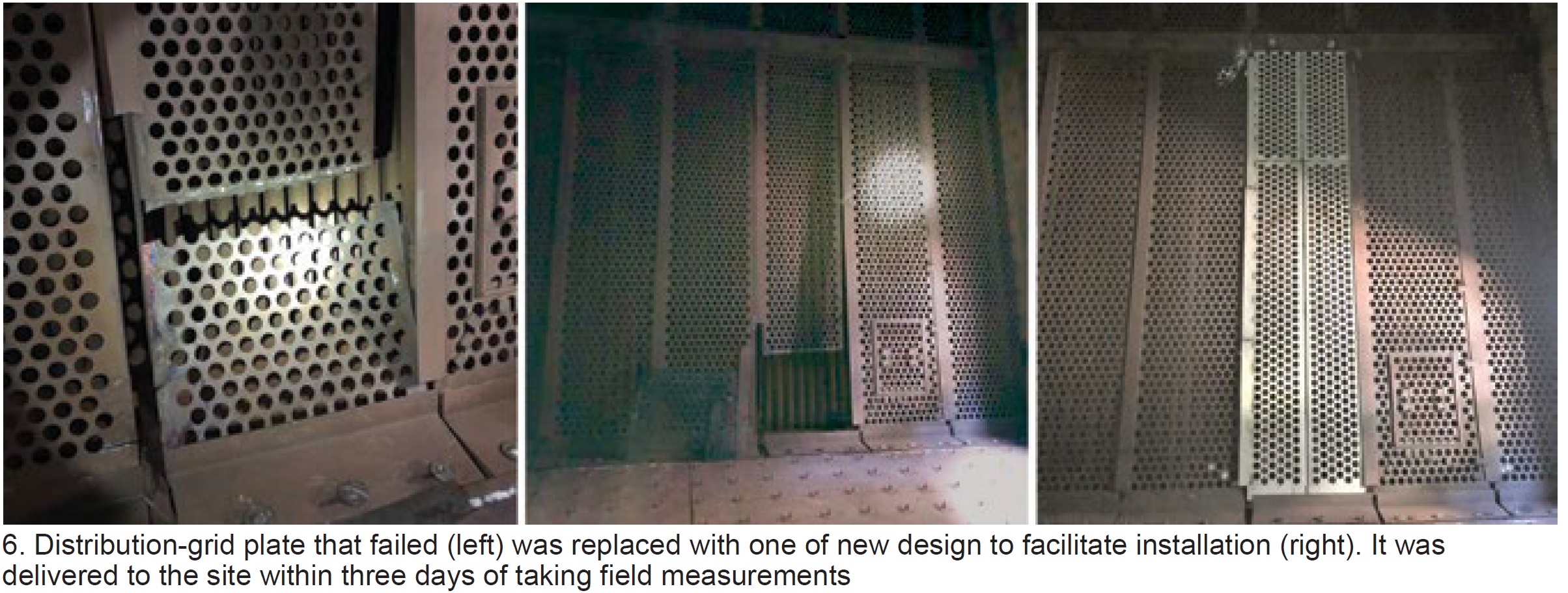
Generator testing: What the tests mean and how they are resolved
AGT Services Inc
Jamie Clark had a simple objective here: Identify standard tests and inspections—electrical, mechanical, and visual—that plant personnel should be familiar with to avoid operational surprises and to assure the highest level of equipment reliability possible. He provided examples of both bad and good test results, and offered recommendations and corrective actions to achieve the stated objective.
Here’s the lineup of components Clark recommends inspecting:
- Stator winding: Endwinding support system, wedge system, gas-gap baffle studs, rubber baffles, and bushing box for hydrogen-cooled machines.
- Stator core: Tightness, iron migration, damaged/overheated laminations, and vent duct blockage.
- Field (rotor): Cleanliness, arcing between wedges, hot spots on tooth tip at wedge joints, retaining-ring condition, borescope look under retaining rings, collector-ring condition, fan damage, and copper dusting.
This is a good presentation for a lunch-and-learn in the plant break room. Details are at a minimum, photographs are excellent.
Considerations for the fleet management of gas-turbine lubricants
EPT Clean Oil
Company specializes in ion-exchange-based lubricant treatments and oil testing in critical applications. It maintains an on-going R&D program focused on advancing the science of lubricant management.
Peter Dufresne’s goal was to help owner/operators see the value in treating their lubricants as an asset, rather than as a consumable, and to understand and use the tools at their disposal to manage that asset. Here’s an “executive summary” of the plan he suggests users follow. Details are in the 49-slide PowerPoint.
- Complete oil analysis done to ASTM standards.
-
- Track and monitor rates of additive consumption.
- Predict end of lubricant life well in advance.
-
- Use a conditioning system to manage oxidation.
-
- Eliminate potential for varnish and reduce rates of additive consumption.
-
- Purchase high-quality oils from a reputable manufacturer/supplier.
-
- Consider an annual 5% top-up.
-
Lincoln, Crete earn Best Practices Awards
Peaking plants Lincoln Generating and Crete Energy Venture were the only facilities in the 7EA fleet recognized for their best practices in 2021 (details below). Interestingly, both are operated by Consolidated Asset Management Services LLC (CAMS) and managed by Brad Keaton, facilitating the sharing of best practices for maximum impact. Lincoln, located in Manhattan, Ill, has eight simple-cycle units, Crete, located in Crete, Ill, four.
Safety, reliability foremost when purchasing a mobile fall-protection system
Several locations at Lincoln Generating Facility and Crete Energy Venture required fall protection where no adequate tie-off points were available. One of the most notable: Generator circuit-breaker platforms at Lincoln (Figs 7 and 8). When performing generator breaker work from the platform, personnel had adequate fall protection. However, the work often required climbing up to a higher level, which exposed workers to a fall risk and therefore the need for fall-protection harnesses.
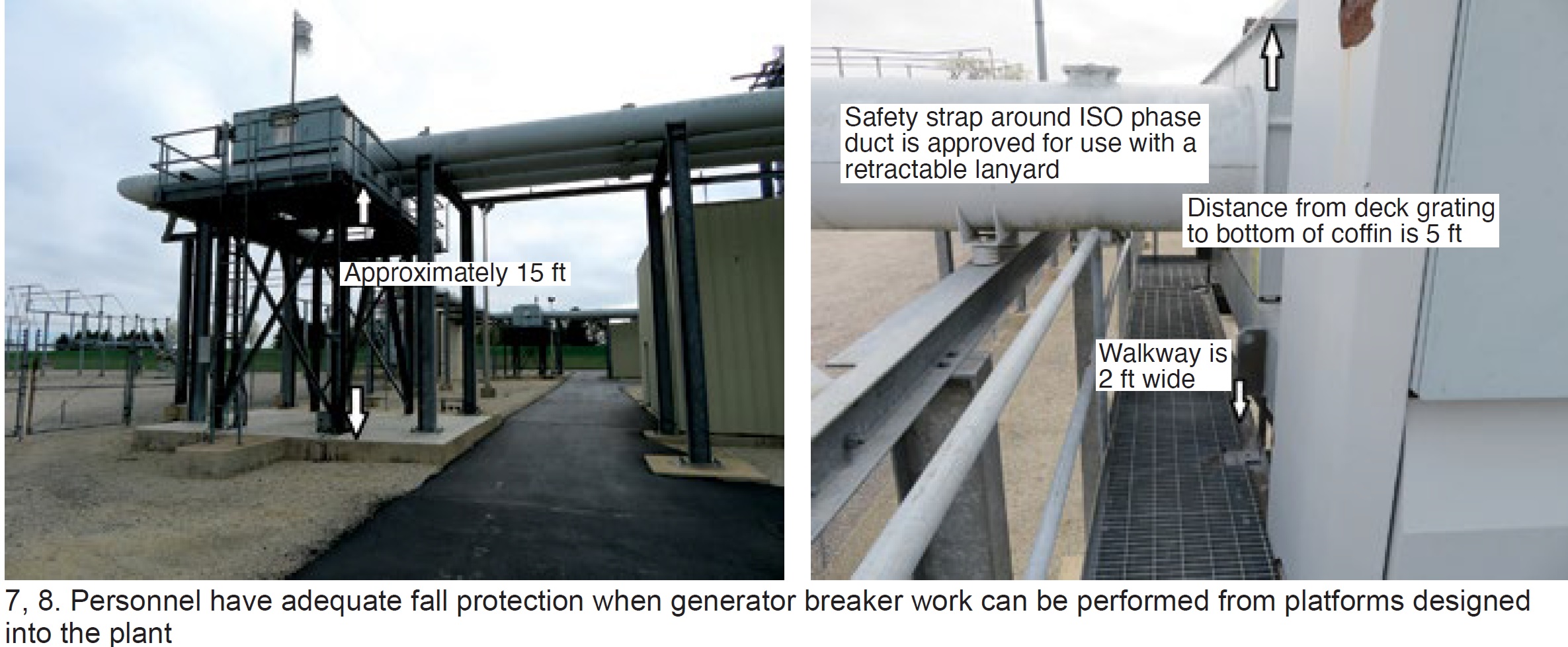 A problem arises when the technician is standing on the highest point in the area and is only able to tie off to the equipment that he/she is standing on. If the person were to fall to the platform below, the fall protection would not work, because the drop is less than the distance required to fully engage the fall-arrest lanyard, but it’s still high enough to cause serious injury.
A problem arises when the technician is standing on the highest point in the area and is only able to tie off to the equipment that he/she is standing on. If the person were to fall to the platform below, the fall protection would not work, because the drop is less than the distance required to fully engage the fall-arrest lanyard, but it’s still high enough to cause serious injury.
If the technician fell off the structure entirely, the fall-arrest equipment would come into play; however, there is a possibility of injury by the fall-arrest system because of the distance the worker would drop before activation.
Lincoln staff explored numerous options over the years to eliminate the fall risk described—including temporary scaffolding during planned maintenance, which was not practical when required for unexpected issues forcing the unit into an outage. Permanently installed tie-off points proved costly because of their installation and periodic testing requirements.
Personnel observed a demonstration of an OSHA-approved mobile tie-off system, which could be used in many different locations at Lincoln, and shared with Crete (Figs 9 and 10). The system demonstrated had tie-off points for three workers. It received owner approval and an OSHA-approved system was purchased.
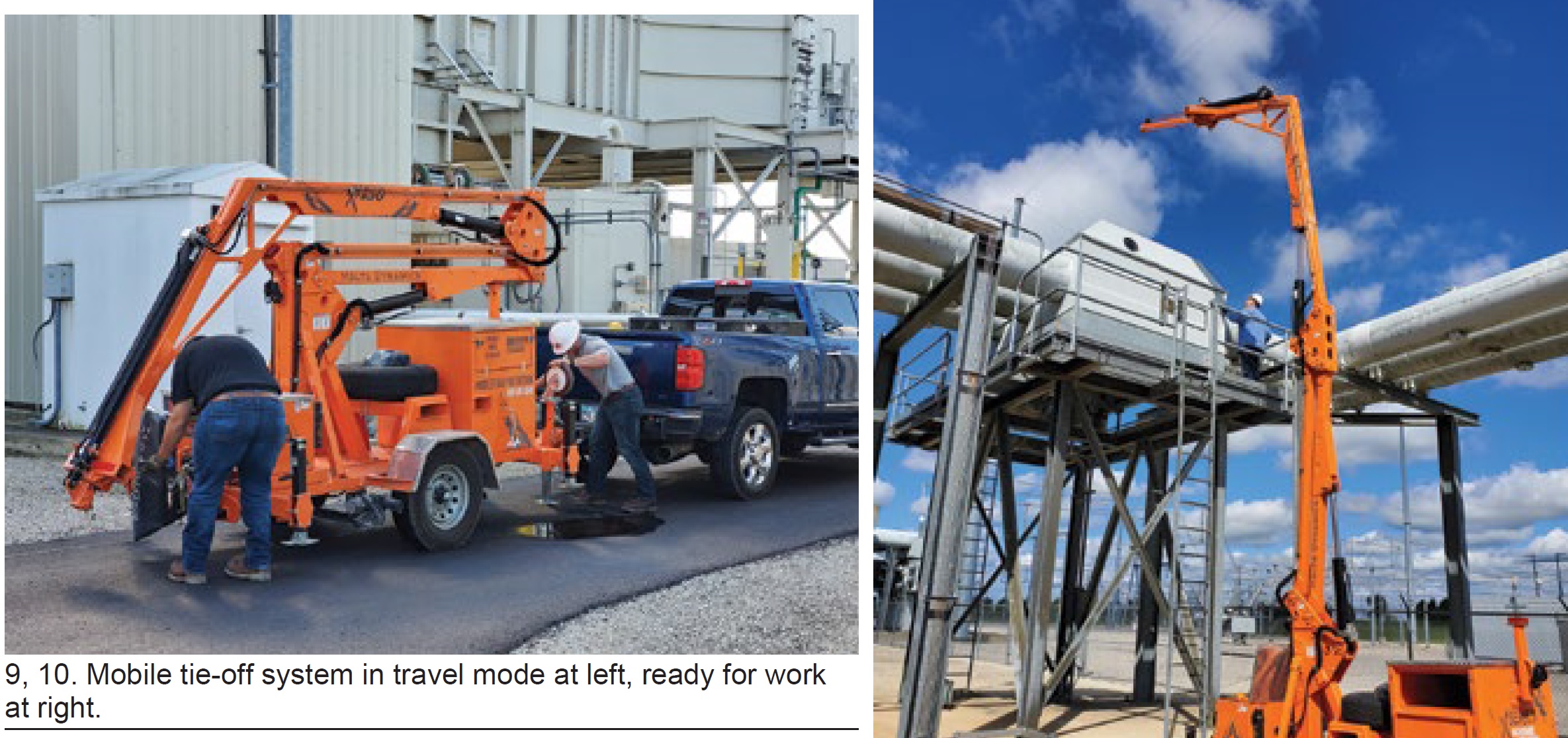
The mobile tie-off system has been used successfully in many locations at Lincoln and Crete. Its proven benefits include the following:
- Cost was half that for permanently installed systems considered for just the generator circuit-breaker platforms.
- The mobile system has tie-off points for three workers, which is adequate for the work scopes plant personnel perform.
- Scheduling and coordination of temporary scaffolding during outages is no longer required.
- Staff now is capable of safely performing emergency repairs.
Mark V lifecycle, reliability improvements produce dramatic results
Crete Energy Venture, commissioned two decades ago during the gas-turbine boom, was experiencing challenges with obsolescence, parts availability, and OEM support. This was especially true for the Mark V gas-turbine control system. OEM declarations ceasing production support of system components in 2014, outdated HMI interfaces and hardware, limited OEM training offerings, plus the wear and tear of daily operation, led staff to investigate methods for the continued reliable operation of the control system.
After performing their due diligence, it became clear to plant management that a full control-system upgrade was not necessary, as multiple third-party vendors provide solutions for parts repair/replacement and field service support, and the functionality of the TMR (triple modular redundant) Mark V controls remained robust. Staff determined that multiple methods of improvement were available for a comprehensive control-system reliability program and implemented the following solutions:
Mark V health checks. Since 2016, Crete has hired a third-party vendor on a biennial interval to perform reliability assessments of the Mark V control panels and associated equipment. It identified numerous issues lingering below the surface which eventually could have caused forced outages if not addressed.
Mark V cards, ribbon cables, and instruments have been replaced proactively during the assessments, and bad wiring terminations in remote junction boxes have been corrected. The permanent clearing of what could be considered nuisance Mark V diagnostic process alarms and dc-equipment grounding issues also was a site priority during the process. Result: The plant now experiences significantly fewer unplanned equipment failures than previously.
Inventory management. After the initial increase in site inventory and the addition of firmware revision-specific spares—such as EEPROMs (electrically erasable programmable read-only memory)—plant personnel continued to discuss optimized plant inventory levels for each Mark V card and component during every reliability assessment.
Increased inventory levels of high-use/high-failure-rate boards, like the TCEA and TCPS, have proved beneficial on multiple occasions, reducing downtime during controls-related upsets. Crete also replaced the GE TCPS power-supply boards with an upgraded aftermarket version from GTC Control Solutions after experiencing a failure or alarm condition that predicted future issues. Any used card, or one of unknown condition, that may have been replaced during troubleshooting also is sent to an outside vendor for a condition assessment and in-panel test to ensure that all site inventory is functional upon installation.
BOP PLC upgrade. The original installation used an obsolete pairing of GE Fanuc 90-70 and 90-30 PLCs—each with limited parts availability, single CPUs, and the need for a no-longer-supported Genius Bus Module communications device (Fig 11 left). Personnel determined that because of obsolescence, single-point-failure risk, and limited forward compatibility, this PLC should be replaced. The latest product offering from GE was selected and a fully redundant RX3i PLC was installed by Innovative Werks in fall 2019 (Fig 11 right).
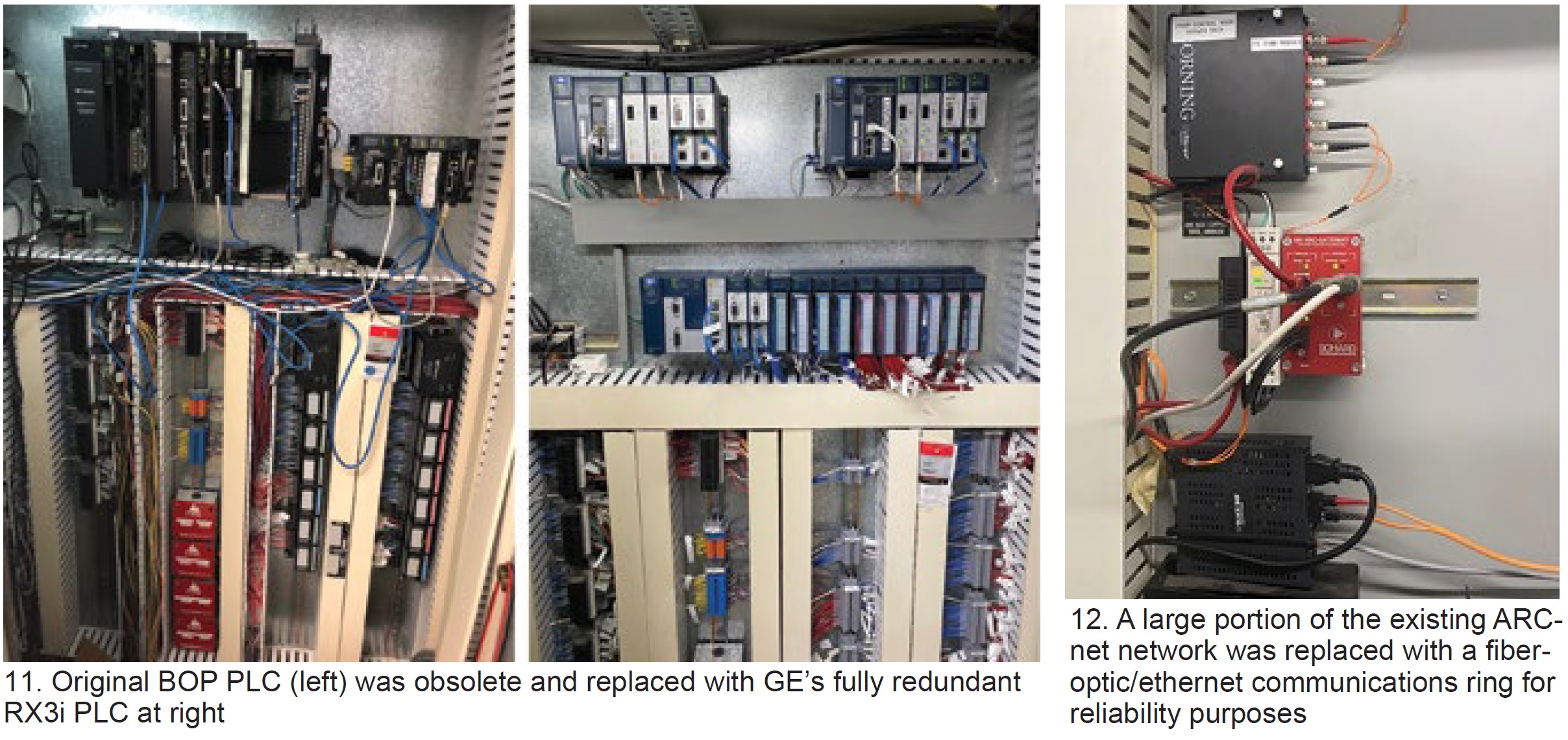
HMI upgrade. The site’s OEM Cimplicity HMI servers were a major point of concern when assessing overall reliability, cybersecurity, and functionality of the turbine control system. Continued hardware issues required extensive man-hours for monthly server backups and re-boots to prevent server and ARCnet lockups. Plus, the Windows XP platform had long been obsolete, increasing cybersecurity vulnerability.
Additionally, the existing system had only one Mark V server in the control room and one in Unit 2’s packaged electrical and electronics control center (PEECC), limiting access to logic forcing, signal name, and TC2K reports, as well as to more advanced Mark V engineering and diagnostic tools.
Crete contacted TTS Energy Services to install a redundant server TMOS HMI system in May 2020. The Traffic Management Operating System eliminated a large portion of the existing ARCnet network and replaced it with a fiberoptic/ethernet communications ring, removing a costly and long-lead-time failure point from the control network (Fig 12). Recall that Cimplicity HMI ARCnet cards are proprietary and difficult to source.
This system also did not require any modification or head-end upgrades to the Mark V control panels, making it a very cost-effective solution. The new network topology includes a client HMI workstation in each of the plant’s four PEECCs and the control room, giving technicians full access to the Mark V control screens and engineering tools in all locations.
Easier access to dynamic point logic, trends, and signal names/values directly from the control screen provides a more intuitive operator interface, allowing for reduced troubleshooting time during abnormal plant operating events and a more simplistic training process. It also provided the site with state-of-the-art Windows Server 2019 and Windows 10 operating systems. Continued patching and Windows support for these machines allow Crete to maintain a high cybersecurity standard on the controls network.
While each of the aforementioned projects individually would have had a positive impact on the lifecycle of the existing Mark V controls system, Crete has seen marked improvements in hardware reliability and system functionality after implementing the full program. Mark V card replacements, when required, typically are done proactively, rather than reactively.
Operators are able to efficiently troubleshoot Mark V alarms using advanced tools and user-friendly interfaces with files such as Help.QD (Fig 13) and direct click access to dynamic logic rungs. Technicians learning Mark V can be trained on specific tasks with ease, removing the tedious and time-intensive process of learning and perfecting the exact syntax and terminology used in command prompt.
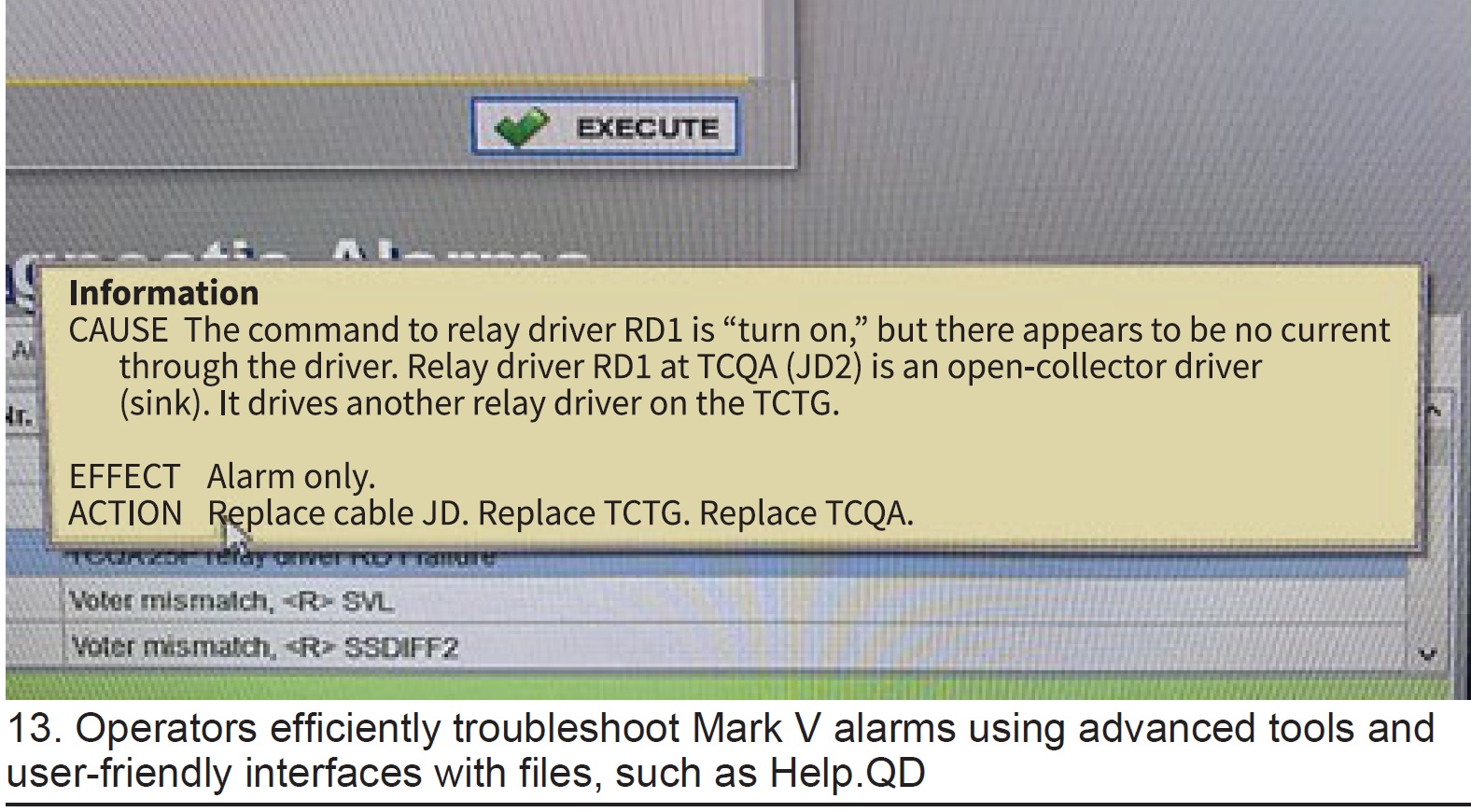
Additionally, the TMOS came quipped with a historian, giving personnel access to higher-resolution operating data without requiring a View 2 file to be running to capture operating events.
With the process improvements described, and with resources in place, site personnel are confident they can continue reliable and sustainable operations with the Mark V control system for many years to come.
LED lighting upgrades make for safer maintenance, operation
With a staff of three, the Crete site continuously explores methods for optimizing maintenance activities and eliminating high-man-hour tasks that don’t directly contribute to the site’s high standard for safety, reliability, and availability. While evaluating the facility’s equipment condition and the man-hour contribution of different systems, staff determined that a significant amount of time was being spent on changing MCC indicator lights and fluorescent building lights. Plus, a man-lift rental was required annually for street-lamp replacement.
Constant lighting failures also presented a safety concern, because failed indicator-lamp sockets can cause confusion on equipment operating status. Plus, plus, ergonomic constraints for replacing other fixtures increased hazard exposure. Considering these issues, as well as the potential to improve energy cost efficiency and reduce hazardous waste generation, plant personnel pursued an alternative, and simple, solution.
Advances in LED lighting technology afford industrial facilities the opportunity to upgrade lighting cost-effectively. Plant personnel researched product offerings and found solutions for the majority of the site’s lighting fixtures. Outdoor high-intensity-discharge (HID) lamps were replaced with LED equivalents expected to reach more than 94,500 hours of useful life with vastly improved light dispersion and output.
MCC indicator lights and sockets in the PEECCs were replaced with relampable LED fixtures that have a much brighter display and required no modifications to wiring or bucket mounting. The control building, switchgear building, PEECCs, generator breaker cabinets, and accessory gears all were retrofitted with LED lighting solutions over the last three years.
Today, the only remaining non-LED lights onsite are the turbine-compartment and fuel-gas-module lamps because there are relatively few product offerings that can withstand the operating conditions and/or regulatory requirements for hazardous atmospheres.
After the lighting upgrades, the man-hours required to replace failed lighting has been reduced from about 200 hours annually to fewer than 20. Hazardous waste generation related to lighting (as well as universal waste from ballasts) has virtually been eliminated because all remaining non-LED fixtures are incandescent bulbs. The improvements to site safety also are notable, as better work-area lighting and reduced hazard exposure are in line with Crete’s commitment to employee safety and continuous process improvement.
Gas turbine systems produce over one-third of US electric energy requirements. They provide reliable baseload power, in addition to that required to support the intermittent production of electricity from renewable sources. According to a recent Washington Post article, “Turns Out Wind and Solar have a Secret Friend: Natural Gas,” every 0.88% of capacity from renewables needs 1% capacity back-up from a fast-reacting fossil-fuel system.

Thus, gas turbines, a cornerstone energy conversion technology for the efficient production of electricity and heat today, are destined to play an important role in the emerging global quest for zero carbon emissions, says Dharam Punwani, executive director, Turbine Inlet Cooling Assn (TICA).
He reminds that increases in ambient temperature and humidity adversely affect the output and energy efficiency of all gas turbines (Figs 1 and 2). Since high ambient temperatures reduce gas-turbine performance, the logical solution for preventing this adverse effect is to cool the inlet air before it enters the compressor. Several technologies have been used successfully for this purpose.
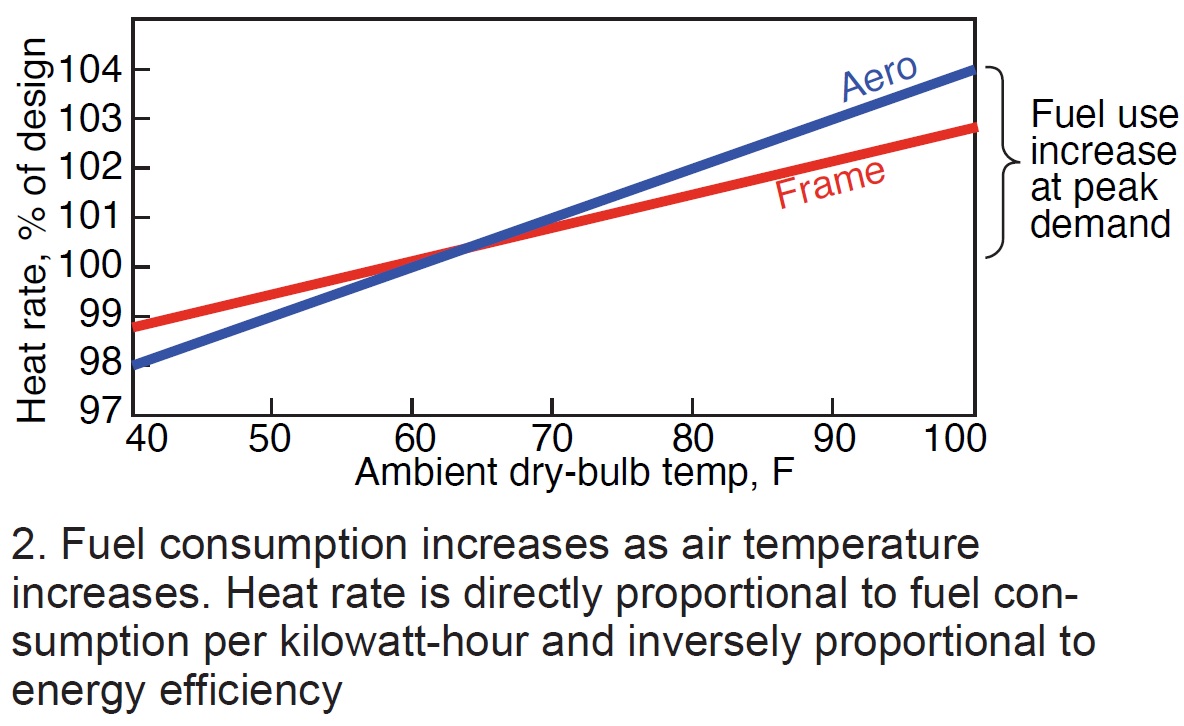
The Turbine Inlet Cooling Assn’s (TICA) website at https://turbineinletcooling.org is an excellent source of information on these solutions, especially recorded webinars bulleted here:
- Adiabatic wetted media evaporative cooling
- Fogging for evaporative cooling
- Wet compression
- Indirect heat exchange with chilled water
- Thermal energy storage for chilled water indirect heat exchange
- Hybrid cooling
The website also includes an inlet-cooling performance calculator, database of installations, and library of publications and presentations on all technologies.
Bear in mind that each technology has its pros and cons. No one technology is best suited for all applications. Selection of the optimum technology for your plant depends on many factors—including gas-turbine design, weather data for the plant location, value of additional electrical energy produced, and the value of unitized fuel saving.
The following summarizes the benefits attributed to cooling of gas-turbine inlet air:
- Increased power output.
- Increased energy efficiency.
- Reduced emissions per unit of electric energy produced (higher efficiency).
- Reduced grid-wide emissions (reduced need to operate less-efficient systems for meeting grid demand).
- Increased thermal energy in exhaust gases, which benefits combined-cycle and cogeneration systems.
- Lower capital cost compared to the addition of a peaking unit to increase capacity.
Because combined cycles are the most efficient fuel-fired option for producing electricity, upgrading with inlet cooling eliminates the need to operate a less-desirable alternative—such as running a simple-cycle peaking turbine with a rated capacity equal to the combined-cycle output gained by adding inlet cooling.
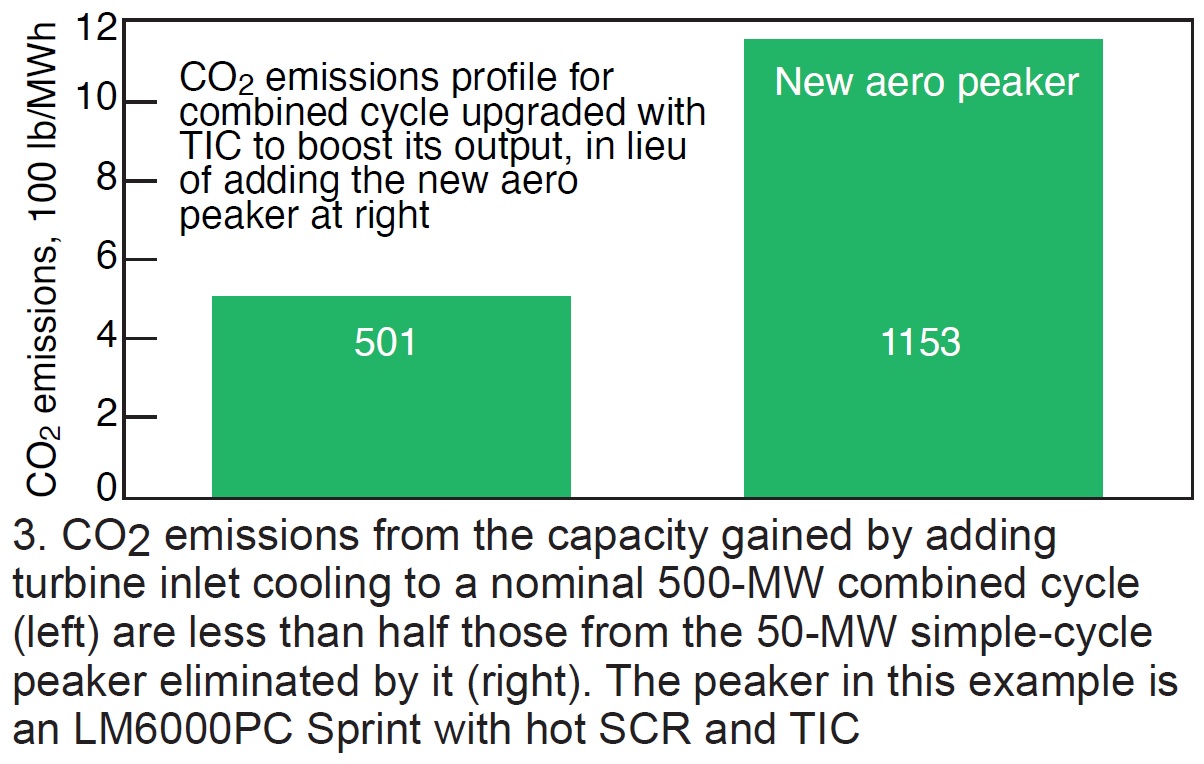
Examples of the quantitative benefits of using TIC on a 500-MW combined-cycle system for reducing emissions of carbon dioxide and regulated pollutants, are compared in Figs 3 and 4 to the emissions from a simple-cycle peaking turbine whose need was eliminated.
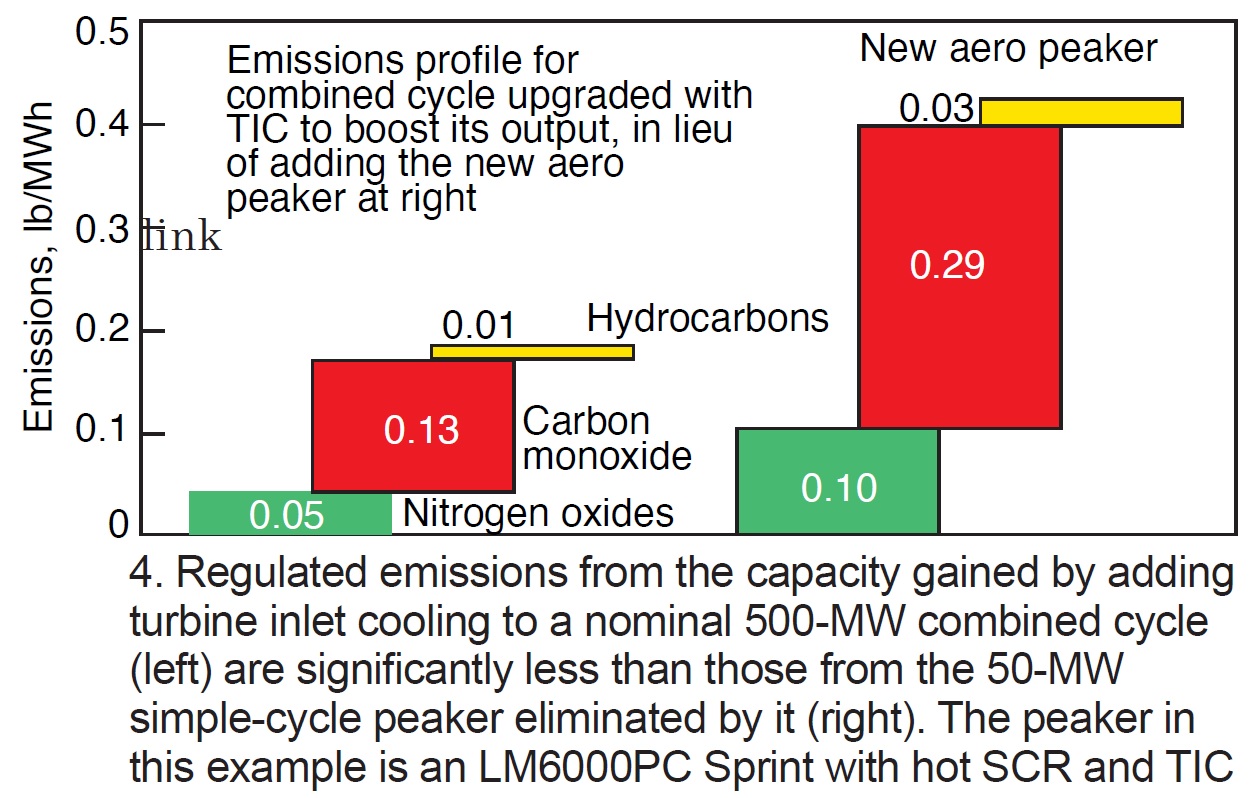
Similarly, installing inlet cooling on simple-cycle turbines eliminates the need to operate less-efficient systems.
According to an estimate by TICA, the use of inlet cooling on all combined-cycle systems in the top 20 states can reduce carbon emissions by more than 22 million tons annually.
Sometimes it’s best to start at the end. During Ethos Energy’s October webinar, “L-0 Blade Repairs,” Ian Saeger, manager of project engineering, concluded by stressing that last-stage steam-turbine blade repair is usually at least 50% less expensive than blade replacement and accomplished within a few weeks—if the repair can be done onsite or in-situ. The latter means with blades still attached to the rotor, the former when the blades are removed but still onsite. If blades have to be shipped to a shop, count on adding up to six months in the schedule.
Saeger began by polling the audience on primary causes of their L-0 blade replacements. Not surprisingly, 69% responded erosion, 10% root cracking, and 21% other. He then reviewed three repair case studies involving (1) water-droplet erosion, (2) cover cracking, and (3) severe foreign-object damage (Fig).
During the Q&A, Saeger noted that most blades with a stainless-steel base can be weld-repaired. Titanium blades, on the other hand, can be welded but only in a shop vacuum furnace. However, not all blade damage is repairable. Damage near the tips generally is amenable to weld repair; damage at the base of the airfoil typically requires blade replacement.
Another useful nugget: In-situ repairs don’t generally require high-speed balancing afterwards, if done within Ethos’ specifications and airfoil geometry remains the same. When asked if there is a limit to how often a blade could be repaired, Saeger said he wasn’t aware of any limit on the frequency.
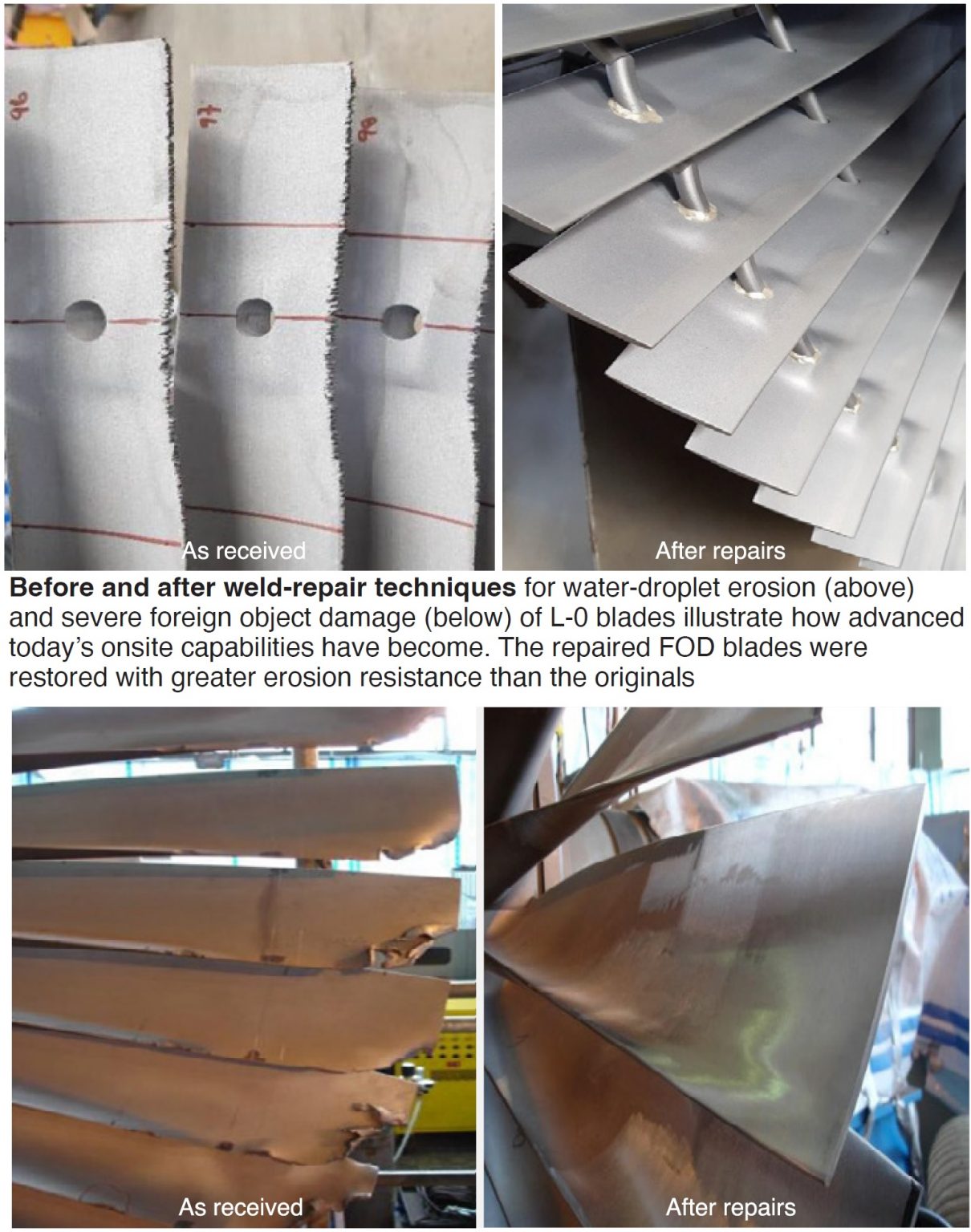
Saeger’s last slide went beyond the topic and identified solutions for D11 and A10 steam turbine/generators specifically—including the following:
- L-0 blade erosion and root cracking (see GE Technical Information Letter 1795)—40-in. L-0 root and airfoil modification. Note that the company’s repair for root cracking caused by low-cycle fatigue is a proprietary upgrade.
- N2-packing casing cracks/leakage (see GE TILs-1627-R2 and -1749)—redesigned N2 box.
- Outer-casing joint leaks—machining of outer casing joint and hardware upgrade.
- HP/IP rotor vibration/runout/bowing—rotor straightening.
- Repetitive seal failures—EEG’s Smart™ Seals.
- Diaphragm axial distortion (see GE TIL-1589)—diaphragm trailing-edge and stiffening mod.
Users (approval required) can access this recording by registering at the following link:
https://attendee.gotowebinar.com/register/8437130390099617037?source=ccj
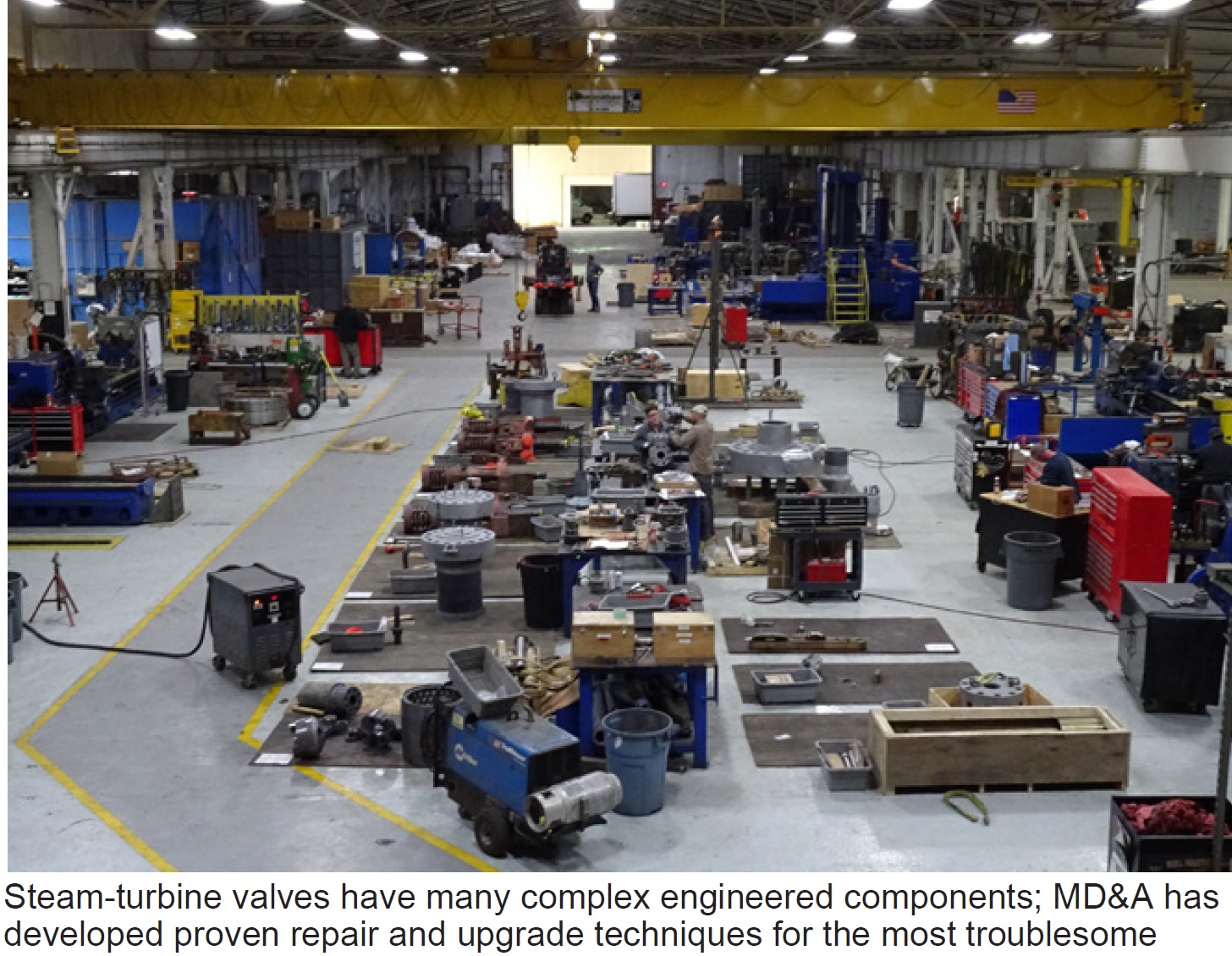
It only takes 2-3% steam overflow to trigger a steam turbine/generator (ST/G) overspeed event, cautioned Dean Casey, project manager for machining services at MD&A, to stress the importance of main-steam-valve inspections and timely repairs. During his presentation in MD&A’s fall series of webinars, “Steam Turbine Valve Outage Common Issues,” Casey went on to say that the failure of the main-steam stop valve to close is the most frequent cause of ST/G overspeed events.
Casey then led his audience through the often-arcane repair process details associated with these complex engineered components.
If you have main-steam valves approaching three to five years, or 25,000 hours, of operation, MD&A’s minimum recommendation for inspection and repair, you owe it to yourself to listen to the webinar. This is especially true if you are past the first five years of plant operations, when valve issues begin to rise. There are no industry or independent maintenance practices for these valves, outside of nuclear plants, only OEM guidelines, making webinars like this one even more valuable.
Generally, inspection and repair are targeted at: restoring clearances to OEM specs, such as bushing removal and replacement, hardened inserts, and scale removal; achieving concentricity, so that the valve operates precisely on its centerline; sealing and resurfacing to ensure no steam cutting; and attending to foreign object barriers, such as strainer baskets.
More specific topics and case studies Casey addressed include these:
- A bent stem which had to be replaced, along with the valve-stem bushings, and inserted into a re-machined casing fit.
- Solid particle erosion (SPE), which can cut stem life in half if not addressed. MD&A has developed a laser-cladding process for some valve stems. Seats, discs, and pressure seal heads are also affected by SPE.
- Control-valve seat replacement. Casey noted that MD&A has replaced 40-50 of these seats in one OEM’s valves over the last 10 years.
- Strainer basket replacement.
- Specific repairs for spindles and sleeves in Alstom valves, and disbonding and liberation of Stellite hardfacing of Siemens KN valve seats and plugs.
- Indications (cracks, for example) in steam chests and repair options.
With supply-chain issues affecting short-term delivery to all sites, Casey urged users to identify parts for rebuilds well ahead of the outage. Around 90% of MD&A’s parts come through its Parts Div facility in Danvers, Mass, but some can be manufactured in its St. Louis shop, which Casey described as the largest non-OEM gas-turbine repair shop in the US. Examples of the latter include non-hardened bushings, inserts, and sleeves.
Capabilities in the St. Louis shop include (1) a deep-bore TIG (tungsten inert gas) welding machine designed to handle internal diameters from 4 to 30 in. and depths to 50 in.; (2) automated MIG (metal inert gas) welder for IDs from 0.88 to 27 in.; and (3) an induction machine for uniform temperature during post-weld heat treatment.
Access this recording @ https://www.mdaturbines.com/webinar-archive/
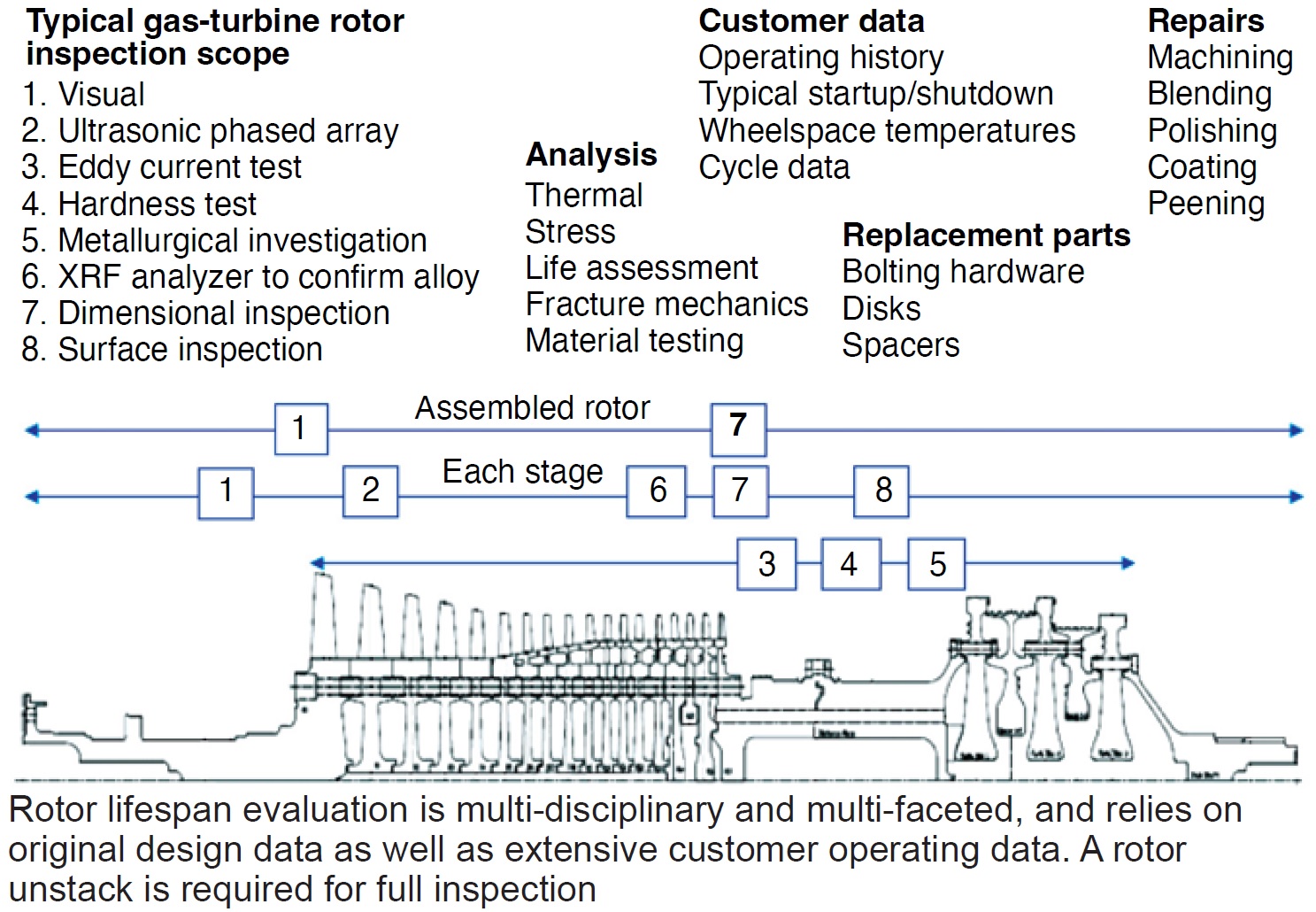
MD&A kicked off its fall 2022 webinar series with a presentation on rotor life extension. You’ll want to take an hour and listen in if your plant has a 7F unit approaching 5000 starts/144,000 equivalent operating hours (EOH) or a 7B through 7EA unit approaching 5000 starts/200,000 EOH. Get the background on these requirements in “Heavy-Duty Gas Turbine Operating and Maintenance Considerations,” GER 3620P, January 2021, available at no cost on the Internet.
Fred Willett explained that MD&A seeks a balance between a standard approach and one customized to address each user’s unique machine characteristics. “All new rotors are the same, but all used rotors are unique,” he said. For this reason, Willett had to answer most of the questions with “talk to our sales rep”—questions such as “What is the lead time for a 7FA rotor?” and “Can you do compressor reblading at the customer site?”
Goal of a rotor lifetime assessment (RLA) is to designate each rotor component for reuse, repair, or replace “for the continued safe and productive operation of the unit” (Fig). For example, thermal transients impact the back-end stages of a compressor far more than the early stages. In one example, Willett noted that new wheels were required for Stages 13-17 while Stages 1-12 could be repaired or reused.
Temperature obviously is the main factor in the stress concentrations in latter stage wheels but Willett also dwelled on the contribution from the “dovetail skew angle” which increases from the front-to-back stages of the compressor discs.
Regarding the turbine section, Willett noted that disks “have had their share of problems,” and in recent years, so too failures of the 1-2 spacer, for which “there is more than one machine failure known.” Importantly, MD&A offers first-stage discs with redesigned cooling slots, has patented a geometry for an upgraded 1-2 spacer, and has upgraded components for all the other rotor problem areas.
Willett touted MD&A’s parent, MHI, and, as an OEM, its “deep domain expertise” in this area. MHI has conducted over 270 comprehensive rotor inspections, with shops and labs in the US and Japan. Some of that expertise was obtained by reverse engineering and manufacturing rotors which were purchased by customers but never installed or operated. When one listener asked if MD&A’s upgraded components also have durability improvements, compared to the OEM, Willett’s answer was an unequivocal “Yes.”
The slides include some very insightful heat maps of compressor rotors during different points along the startup and shutdown sequence, as well as detailed diagrams of component stress concentration points.
Access this recording @ https://www.mdaturbines.com/webinar-archive/
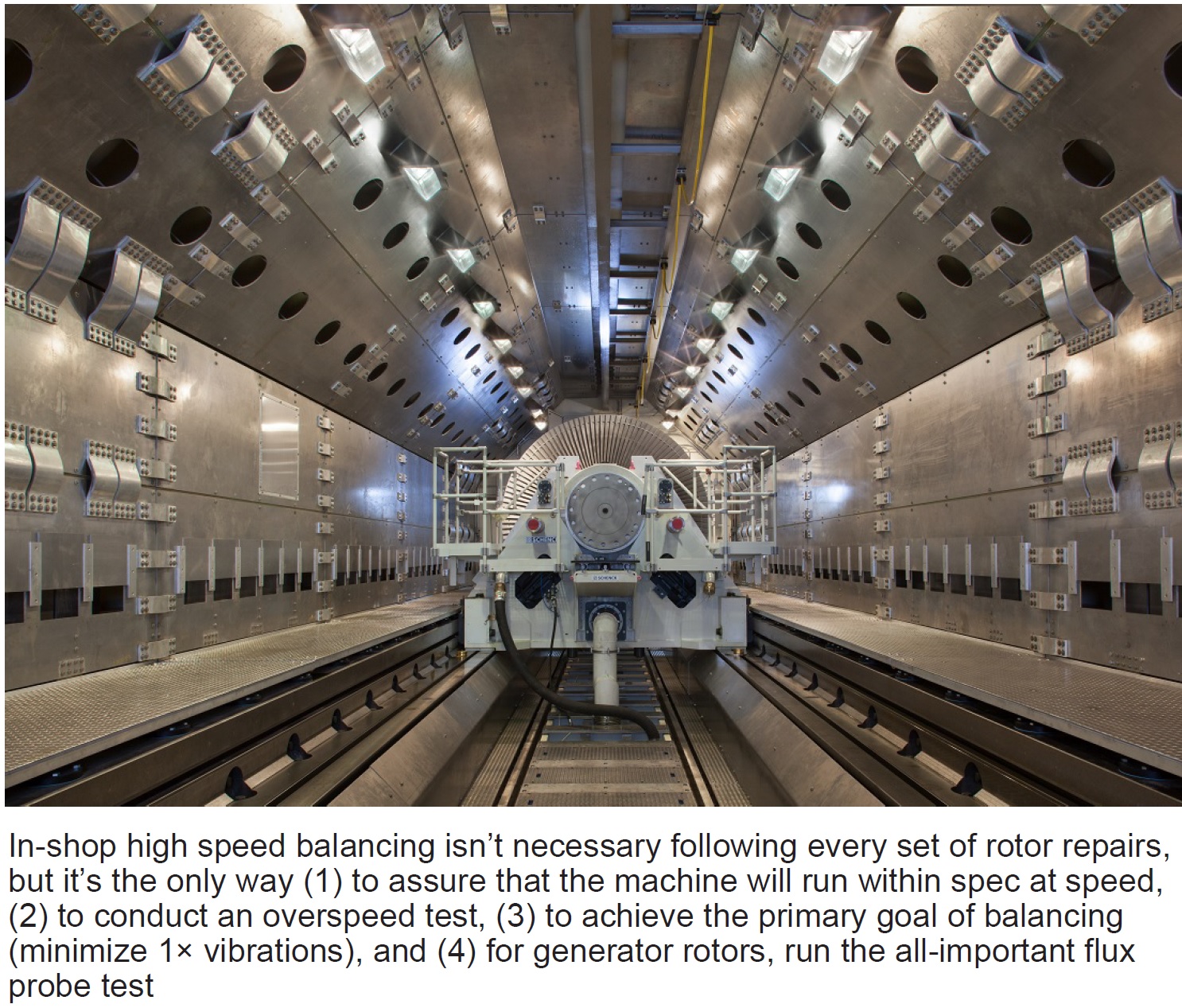
The underlying message of MD&A’s third webinar in its fall 2022 series is that a shop which has invested in a high-speed rotor balancing (HSB) machine (photo) offers the user clear advantages in shortening outage schedules and avoiding the risk of having to transfer the machine from the shop where repairs are made to a shop with an HSB.
Not all rotors require HSB after being repaired, noted MD&A’s Keith Collins, in his presentation entitled, “High-Speed Balance.” If repairs are minor, a low-speed balance (LSB) will suffice, or even an onsite balance. But if the rotor has undergone journal machining, heat straightening, or weld repairs, as a few examples, you should opt for HSB. Ditto if any repairs have altered rotor geometry or local stresses.
For a generator rotor, the big advantage of HSB is the ability to perform a flux probe test, the “only way to guarantee no shorts at startup,” said Collins. Turn-to-turn testing in the shop cannot detect speed-sensitive shorts. “If the rings come off your generator rotor you should do a HSB. This is true for a rings-off inspection or a rewind with new or existing copper,” he stressed.
For all rotors, the HSB also allows for overspeed test and comprehensive vibration analysis.
The bulk of Collins’ slides offer a tutorial of sorts on topics including applicable standards, vibration measurement basics, critical speeds, modal balancing, overspeed test and balance, electrical testing, and heat and stability runs.
During the Q&A, Collins added that an onsite balance should definitely follow an in-shop HSB, with experts present to determine need for additional trim shots. On the subject of whether MD&A “heats up the GT/G or ST/G rotor in the shop for HSB, Collins replied that they typically do not, though other shops do. “We can draw partial vacuum to heat up the blades which transfers heat to the rotor for soaking,” he said.
Regarding the question, “Should you do an onsite LSB after a partial re-blade,” Collins replied “Yes. Do an LSB before and after the repairs.” To a similar question of doing an LSB after replacing all blades in an ST/G rotor, Collins also replied “Yes.”
Access this recording @ https://www.mdaturbines.com/webinar-archive/
The Turbine Inlet Cooling Assn (TICA) announces that its annual awards to owner/operators of GE aeroderivative gas turbines who have demonstrated the successful implementation and use of at least one turbine inlet cooling (TIC) technology will be conferred during the 2023 Western Turbine Users Inc (WTUI) Conference (March 12-15 in San Diego).
One award will be given for each TIC technology. Presentations will be made during the organization’s luncheon on Monday, March 13. Awardees must be present to accept their awards.
Nominations will be evaluated using the following criteria:
- Number of turbines with TIC (20%).
- Total power increase (kW) due to TIC (20%).
- Percent increase in capacity by TIC (20%).
- Ages of TIC installations; older the TIC system, better the score (20%).
- Noteworthy/innovative details of the TIC system or its use (20%).
Each award recipient will receive:
- A plaque for display at the power plant.
- Awardee name and system info posted on the TICA website.
- Awardee name and its system highlighted in a TICA press release to industry publications.
- Complimentary one-year TICA membership.
- $100 VISA gift card.
Deadline for submitting nominations is January 13, 2023.
Instructions: Complete all required information on the nomination form at www.turbineinletcooling.org and submit it to Dharam Punwani, TICA Executive Director at exedir@turbineinletcooling.org.
Advancements and case studies in film-forming-substance chemistry on display for fossil, geothermal, and nuclear generators
By Steven C Stultz, Consulting Editor
As we prepare for the most comprehensive meeting on film-forming substances to date (see above), a recap of the FFS 2022 follows to bring you and your organizations up-to-speed on the latest science and real-world applications of FFS in generating facilities. Co-chairs Barry Dooley, Structural Integrity (UK), and David Addison, Thermal Chemistry (NZ), organized and led this 2022 conference on behalf of The International Association for the Properties of Water and Steam (IAPWS, www.iapws.org).
Their opening greeting: “Welcome to the virtual world of film-forming substances,” a specialized topic in cycle chemistry control of powerplants and steam generating systems.
The focus: Film-forming substances to protect metal surfaces from corrosion through hydrophobicity. It’s part of the larger effort to control corrosion throughout the water/steam circuits of fossil, nuclear, geothermal, and combined cycle/HRSG plants.
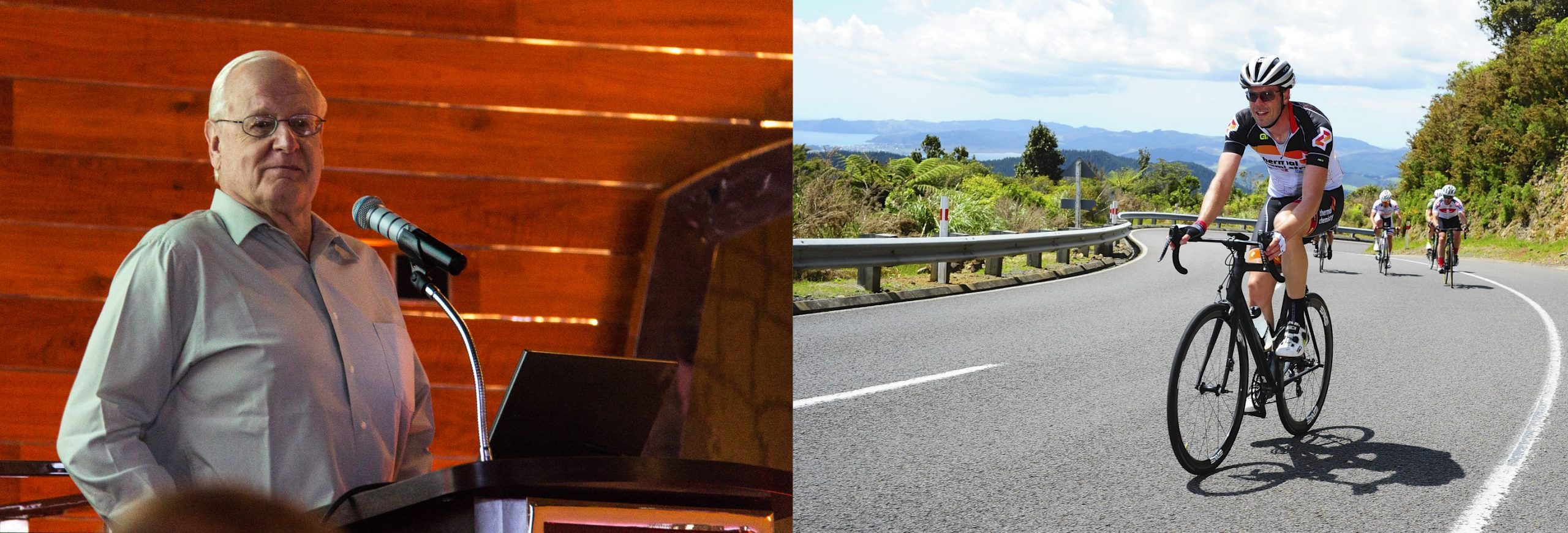
One-hundred forty-six paid attendees—a record—logged in from 30 countries to watch, listen, and participate in 21 technical presentations and discussions. Ten suppliers also presented their credentials and technical details. Participating sponsors of FFS 2022 were Fineamin, Kurita, Nalco Water/Ecolab, Reicon, SUEZ (now Veolia), and Waltron.
FFS conferences, which began in 2017, have become well known as a unique and critical opportunity for plant operators/users to raise questions relating to all aspects of film-forming substances. Dooley stressed the IAPWS goal: “To provide information freely and improve FFS guidance for owners and operators worldwide.”
Below are selected highlights related to combined-cycle plants and operations.
Base definitions
In brief, the term “film-forming substances” represents two main categories of chemicals:
- Amine-based film-forming amines (FFA) and amine products (FFAP).
- Non-amine-based film-forming products (FFP).
There remains general confusion on the nomenclature, but these terms introduced by IAPWS in 2016 have quickly become the global standard.
It is important to note here that the wide range of these products and applications make research and common solutions difficult (table).

Current foundation
“Universally,” explained Dooley, “we are seeing reductions in the measurement of feedwater total iron and copper corrosion products through the use of FFS. There are general visual observations of hydrophobic films in the water-touched areas (mainly feedwater and condensate) of plants, and within air-cooled condensers.
“However,” he continued, “film formation and adsorption remain questionable on steam-touched surfaces.” Also important, a lack of visual evidence of hydrophobicity does not necessarily mean lack of protection.
These complexities, and the underlying understandings of oxide growth, protection, and tube failures, as well as the impact on steam turbines and other plant equipment, make this series of conferences critical for owners/operators of fossil and combined-cycle/HRSG plants, among others.
Cycling and layup protection
Ronny Wagner, managing director, Reicon (Germany), launched the technical presentations with Application of film-forming amines for preservation of water/steam cycles with and without air-cooled condensers. Wagner’s overview covered FFS preservation principles for both flexible operation and long-term layup. He focused on ODA as the film-forming amine (FFA) to offer this fundamentals-only guide.
For cycling units with varying schedules, Wagner explained, a steady and continuous FFA injection at low concentration (50 to 500 ppb) should offer the best protection while offline and should have little to no long-term impact on system water quality. FFA should be injected at the suction side of the feedwater system; the condensate polishing system (if provided) can continue to operate. Any conductivity spike during implementation should return to stable.
For long-term preservation of plants with seasonal shutdown or planned outages, a high feed rate of around 2 ppm should be initiated five to 10 days before shutdown. After shutdown, a lower but steady concentration of 50 to 500 ppb then can be used for follow-up injection.
“After the next shutdown,” he suggested, “it is wise to re-preserve at a high rate (1 to 1.5 ppm) beginning three to five days before the following shutdown. Normal injection is at the suction side of the feedwater system, or in the condensate lines after the polisher.”
The polisher should be bypassed because it will remove the amine from the condensate. Water chemistry values will probably be affected during the injection periods.
Again, these are general rules, Wagner emphasized, “The total FFA consumption for preservation is dependent on surface area, and is both plant and product specific.”
Preservation practices for air-cooled condensers (ACCs) are more complex. Most importantly perhaps, common ACC heat-exchange tubing is carbon steel with large internal surface area, typically thousands of square yards.
ACC design also requires long, large-diameter lines from the LP steam turbine outlet to the ACC upper duct (street), to handle the two-phase steam/water mixture. The tube entries within the ACC upper duct become corrosion-active surfaces for flow-accelerated corrosion (FAC), and there is normally high iron concentration downstream of the ACC during and after startup. Thus, high FFA concentrations at the ACC inlet often are necessary.
ACC case history
A 70-MW combined cycle completed commissioning, but had to idle because of a delayed grid connection. It was critical to protect the ACC. The solution was injection of FFAP (Odacon®) in front of the ACC. Following application, hydrophobic surfaces were visible in the feedwater system and condensate receiving tank (Fig 1).
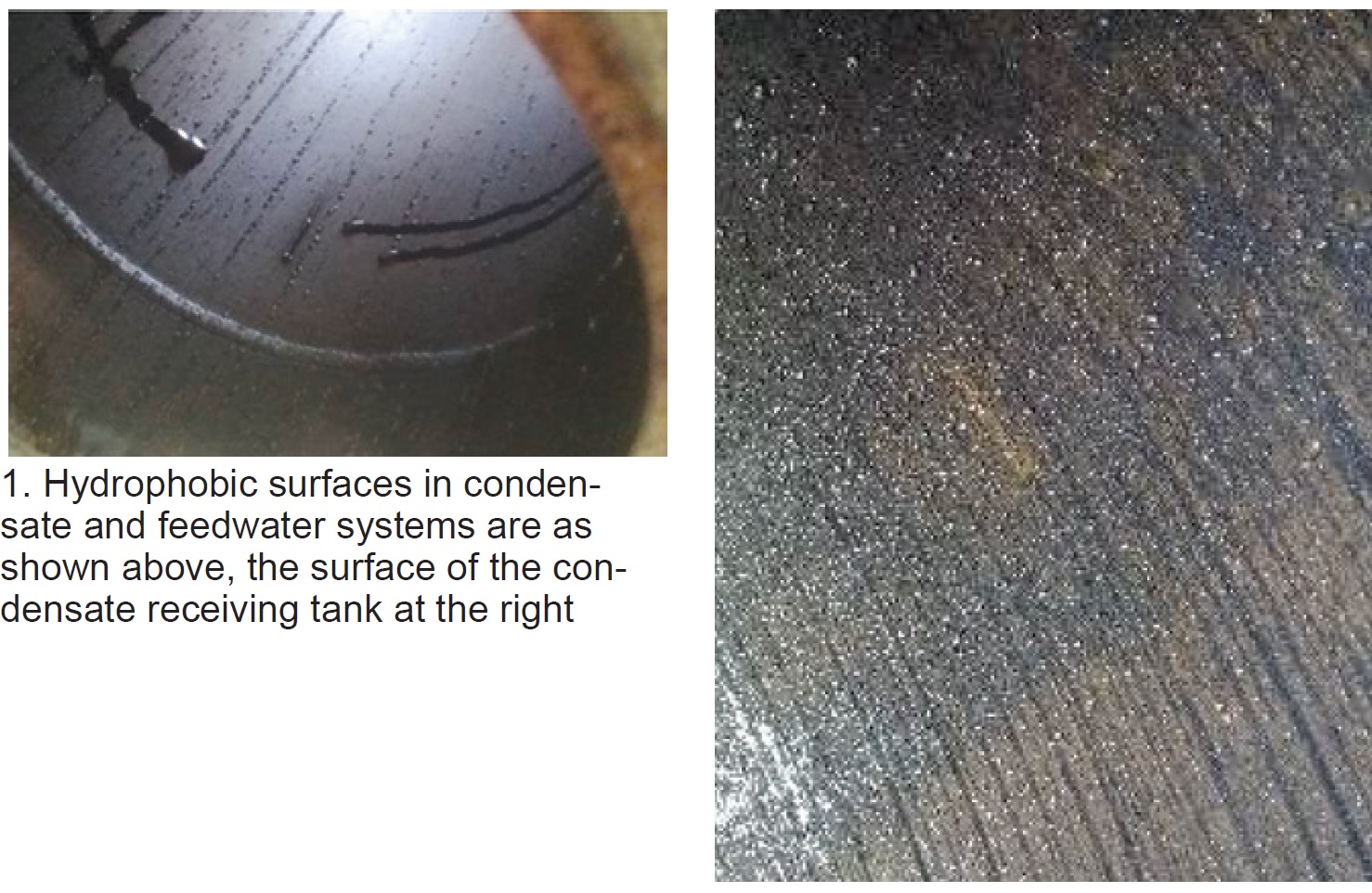
After grid connection and during startup, there were no noticeable issues with corrosion.
Wagner took the opportunity here to emphasize the Dooley Howell ACC Corrosion Index for operating comparisons. Having a proper total iron baseline and use of this index for results comparisons are critical analysis tools to assess FFS impact, he explained. For a clear discussion of the DHACI, access ACC.01: “Guidelines for Internal Inspection of Air-Cooled Condensers” at http://acc-usersgroup.org/Reports.
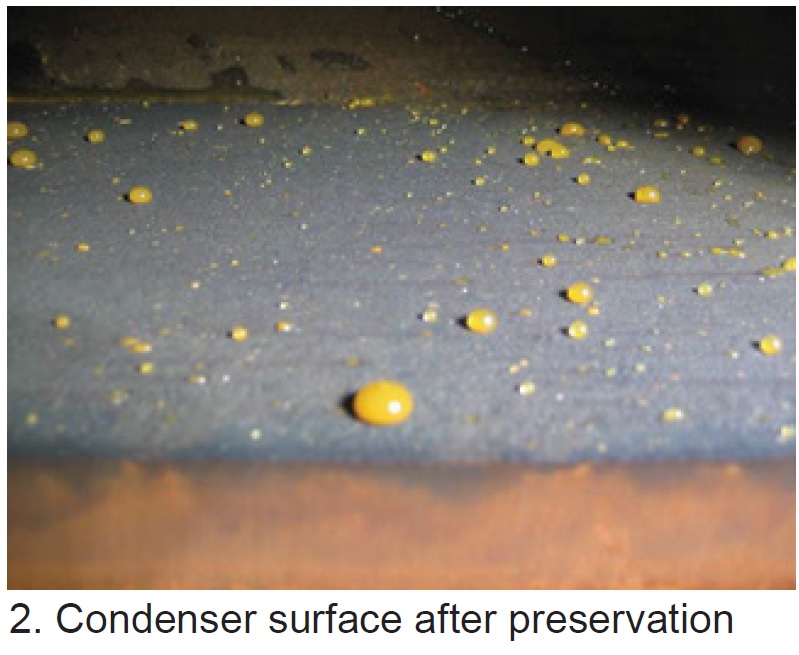 Case study without ACC
Case study without ACC
An 800-MW plant with drum-type HRSG and no condensate polishing unit moved to flexible operation (less time online) and a fast-start requirement. Baseline review showed high iron levels during startup, especially in the IP section of the HRSG.
Preservation was performed in several steps beginning with injection of Odacon in the main condensate line after the condensate pump. Inspection showed hydrophobic protection (Fig 2).
Startup time was halved, and iron concentration in the IP section during re-start was reduced by 70%. For the off cycles, previously-applied nitrogen injection for short-term protection was no longer necessary.
In both cases, total iron transport in the water/steam cycle was reduced.
Biofuels
Attention turned to Agata Zietec, Jönköping Energi, and a combined heat and power (CHP) plant in Sweden burning both household waste and a variety of biomass fuels in two fluidized-bed boilers.
The plant experienced feedwater system issues, including blockages, and preheater FAC. Some parts of the plant were in annual seasonal shutdown for up to five months. Traditional treatment included ammonia and phosphate.
Operators selected Odacon, largely because of positive global nuclear plant experience, and began dosing at the feedwater pump.
The required flow was calculated to be minimum rate at full boiler load and maximum rate at lowest load. To prepare for offline protection, continuous FFS dosing (up to 0.3 ppm amine) was performed from February until the end of the run season (three months).
Iron content in feedwater during startup was significantly reduced and many existing deposits were removed from the turbine area. There was no noticeable impact on online instruments. The applications seem to offer effective protection during layup.
Geothermal
Geothermal processes offer unique challenges in scaling and corrosion. Two case studies were presented focusing on Kurita FFS geothermal technology developments in Turkey and Indonesia.
Worldwide, the most common direct use of geothermal energy is district heating. For power generation, uses include dry steam and flash steam powerplants, binary-cycle powerplants, and combined units.
Common corrosion mechanisms are high salinity, high reservoir temperatures, high gas content, and low pH. Scaling issues come from varying mineral compositions, changes in pressures and pH, water cooling in heat exchangers, and other site-specific issues.
Pilot systems reviewed showed good corrosion protection (Organic Rankine Cycle area), including reduced under-deposit corrosion.
Industrial hot water
A New Zealand dairy factory uses a 10-MW industrial hot water system of carbon steel construction with titanium heat exchanger, introduced in 2019. After two years of operation, the system suffered tube metal loss of up to 56%, according to data provided by IRIS Inspection Services. The system was continually saturated with oxygen and iron levels exceeded 160 ppm with a reducing chemistry program.
Following IAPWS TGD11-19 guidelines regarding steam purity, Odacon was dosed at 0.5 to 1 ppm. Pumps and seals were upgraded to reduce oxygen ingress.
Results showed bulk water iron levels reduced below 1 ppm. Using three to four times the recommended saturation volume for heavily corroded systems, there was a 96.8% reduction in corrosion rate after five months.
Photos were shown of the seven-month inspection in this ongoing program.
Next steps will be an online filming amine analyzer (Waltron), reintroduction of sulfite to see if low oxygen levels have an impact on iron chemistry, change to an optical luminescent dissolved-oxygen (DO) sensor, acid cleaning, and 100% IRIS testing of tubes.
Nuclear experience
Multiple presentations focused on FFS application experience (primarily ODA, octadecylamine) at nuclear plants. ODA has been applied to nuclear facilities in seven countries, and one presentation discussed more than a decade of experience with positive results for feedwater iron levels and measurable particle-size reduction.
The two units discussed, pressurized water reactors commissioned in the early 1980s, are good examples of steam-generator replacement (1996-1997) and turbine upgrades (2010-2011) to continue operating well beyond their original service dates. Water quality becomes even more critical.
In another presentation, Efficiency and harmlessness of film-forming amines used as alternative layup method in secondary circuit of pressurized-water nuclear power plants, similarities also were present. The secondary circuit (steam generators, turbine, and condenser) includes carbon and low alloy steels with surfaces covered by magnetite. During refueling or other outages, oxygen and humidity can lead to generalized corrosion and require layup protection.
Traditional protection methods are either drainage and drying to a relative humidity below 40%, or filling with chemically conditioned water. Both are time consuming and can be difficult.
A presentation by EdF explained an alternative method using film-forming amines (ODA) to inhibit corrosion. Detailed background was given for ODA behavior on different oxide samples at different temperatures, methods used to better understand the related adsorption mechanisms of ODA on various surface states (including testing protocols), and simulations of film efficiencies during layup.
Specifics were presented on morphology and contact angle measurement, electrochemical impedance spectroscopy, chemical composition analysis (ATR-IR and XPS), and other methods.
Beyond these three, presentations dealt with gasket and elastomer testing, and corrosion inhibition by anionic surfactants.
J Fandrich, Framatome, gave an update on the IAPWS Technical Guidance Document for FFS application in nuclear powerplants, a current initiative within the Power Cycle Chemistry (PCC) Working Group. The hope is to finalize this at the IAPWS Annual Meeting in November 2022. Fandrich highlighted the differences compared to fossil water/steam cycle materials, design, chemistry, and steam-generator operation.
At the laboratory
Day Two began with a deep dive into air-cooled condensers, important because they can release significant quantities of iron-oxide corrosion products into the water/steam system serving the entire plant (Fig 3). Risks include HRSG evaporator interior tube deposits (and failures) from iron transport (Fig 4).
Andy Howell, EPRI, took attendees to the upper ducts (Fig 5), “where the corrosion rate is high and tube-entry wall thickness is small.” Corrosion-caused leaks here can draw air into the condenser. This leads to costly performance, maintenance, equipment damage, and availability problems.
In the past, reducing iron levels in the system had been through increasing pH.
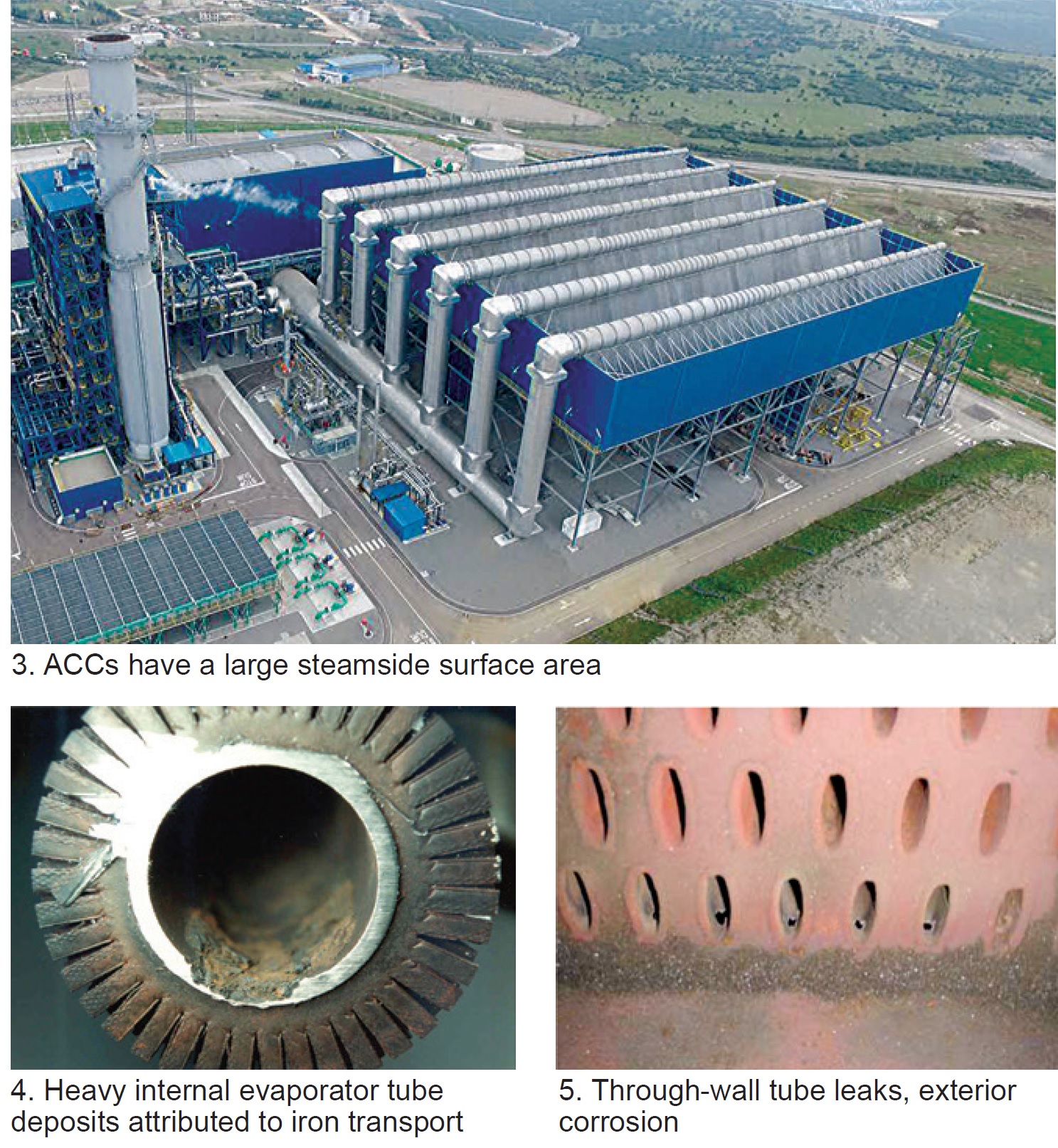
Howell explained a laboratory approach to simulating the ACC steam-side (two-phase) environment at the heat exchanger tube entries. The main results were:
- Ammonium hydroxide involves simple chemistry and is inexpensive; it has proven suitable for system pH control in many ACCs.
- Properly selected and applied neutralizing amines can reduce corrosion in ACCs compared with ammonium hydroxide, and can be used in conjunction.
- FFPs appear to be very effective at reducing corrosion in ACCs under the right conditions.
XPS and EIS
A takeaway mentioned during a discussion period was that university laboratories and staff can help the industry with advancing sciences related to FFS.
One presentation was a deep dive to the molecular level using x-ray photoelectron spectroscopy (XPS). Rob Lindsay, The University of Manchester (UK), offered empirical insights including trial-and-error discussions.
The key target is FFS interface characterization at the microscopic level. This is part of a Manchester research effort into adsorption thermodynamics and interface characterization.
XPS basics were explained and profiles interpreted. Results hope to offer knowledge-based development of the next-generation corrosion inhibitors.
During discussions, Dooley emphasized: “This helps provide key insights, using XPS, to prove the presence of, but not the continuity of films with potential to move away from the standard hydrophobicity tests. This would be a great future outcome for tube sampling and analysis if it can be proven to work in real operating environments.”
The University of Toulouse (France) came soon after, with Adsorption kinetics of film-forming amines on carbon steel surface using electrochemical impedance spectroscopy (EIS). EIS is used to monitor variations of the electrochemical system over time, and to identify the processes occurring at the metal/solution interface. The presentation focused on experimental protocols using submerged carbon steel with and without the FFS OLDA.
Work continues with in-situ monitoring of FFA barrier formation for representative industrial conditions.
As a concluding comment to these presentations, Dooley offered what he believed to be the key takeaway from the lab studies portion of the program: “For the first time at FFS conferences, basic research is presented on film-forming corrosion inhibitors [oleic-based imidazoline (OMID) and sodium lauryl lactylate (SLL)] in different corrosive environments (HCl, H2SO4) than are found in powerplants using XPS and EIS.
“It is hoped that the insights on how the filming molecules interact with metal surfaces (carbon steel) under severe chemical environments at lower temperatures can provide advancements in the studies of FFS on materials in powerplant environments.”
Field-switching of FFS
As a follow-on to last year’s FFS conference, and providing a long-term outlook, PacifiCorp’s Gary Hoffman presented Switching from non-amine FFS to blend of amine/non-amine FFS at the Hunter Power Station.
The subject is Hunter Unit 3, a 430-MW subcritical coal-fired plant in Utah, designed for baseload service, that began operating in 1983. With the owner’s move to increase solar power’s contribution, Hunter 3 is now cycling with daily swings from full load to 10 to 15%.
The last chemical cleaning was in 2012, when nearly 5000 lb of magnetite was removed, and 400 lb of copper recovered. The full-flow deep-bed condensate polishers have been in service since the mid-1990s. Boiler tubes show some under-deposit corrosion.
Chemistry control strategies are:
- AVT(O) chemistry control, ammonia for feedwater.
- Tri-sodium phosphate and caustic for drum pH control during startup.
FFP history was given at the Fourth Annual IAPWS FFS conference in 2021 after two years of Anodamine FFP feeding. On June 28, 2021, operators switched Unit 3 to SUEZ Polyamine Plus based on economics (significant dosage reduction). The program intent remains protection while offline.
The SUEZ second-generation filming technology acts as a dual filmer (FFA and non-amine FFP) that adsorbs quickly and desorbs slowly.
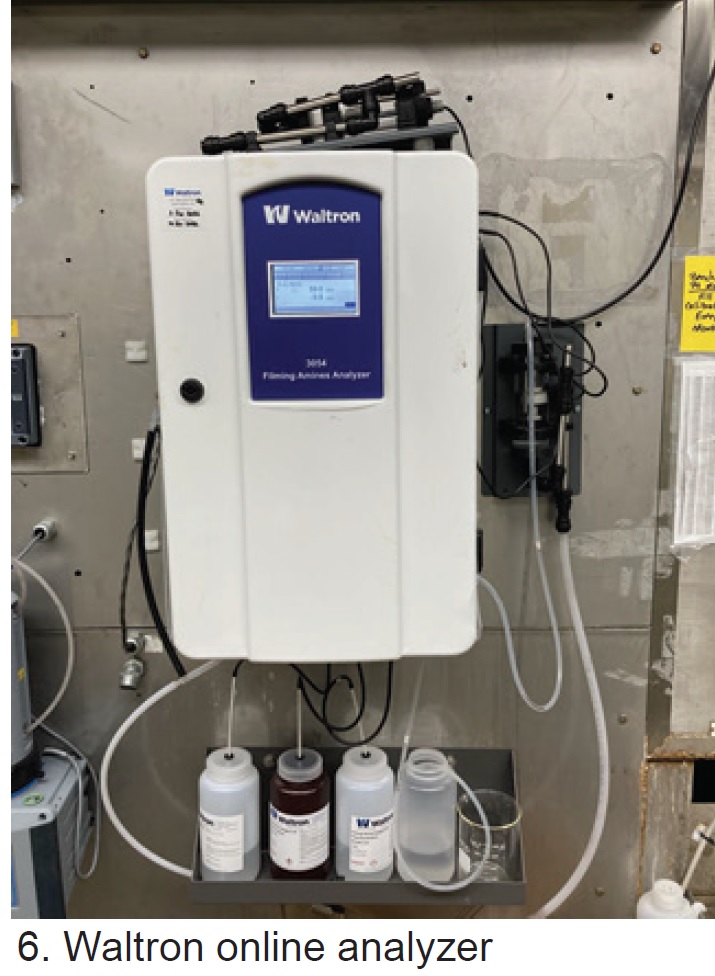 Monitoring and control currently are provided by:
Monitoring and control currently are provided by:
- Online corrosion product sampler.
- Online Waltron 3054 amines analyzer (Fig 6).
- Corrosion coupons on the condensate-pump discharge.
- Grab samples for product concentration analysis.
- DCS controlling chemical feed pumps based on megawatt load.
- Inspections when possible.
During the first eight months, the unit was subjected to eight trips, eight recorded starts, and four outages of more than one day. Moving averages of iron and copper concentrations are shown in Fig 7.

All testing coupons are sent to Lehigh University (US) for XPS analysis. Results confirm the presence of both FFS actives on the surfaces of the coupons. The summary given by Hoffman notes excellent corrosion results during normal operations, with minimal corrosion spikes at startups. The key result is that there was no noticeable difference.
This is an ongoing project, which will also move to other units within the owner’s system. Work continues to measure results and optimize feed rates (currently 1 to 1.5 ppm total product).
One question during discussions pointed to a need for further industry research. That question: “Did you fully remove the first FFS (non-amine) before using the blend?” The answer: “We do not know.”
Dooley later offered a broader perspective: “Further plant and laboratory studies will help confirm the similarity of film properties and protection formed with the wide range of FFS currently on the market.” He invited participants to consider and encourage additional test sites worldwide. In closing the discussion on this topic, Dooley said, “This information was one of the key results from this conference.”
Instrumentation
Waltron’s Hal Stansfield, chief chemist, presented Instrumentation and FFS: the good, the bad, and the ugly. The content was two-fold: development of instruments to measure and control the applications of FFS, and growing concerns that FFS are having damaging effects on existing instrumentation.
On the positive side, Waltron’s online analyzer is effective at monitoring total condensate flow versus the concentration of amines (Fig 8). On the negative side, FFS are creating issues with ion-selective and pH electrodes, dissolved oxygen sensors, and colorimetric analyzers. There are lab reports of sodium electrode failures.
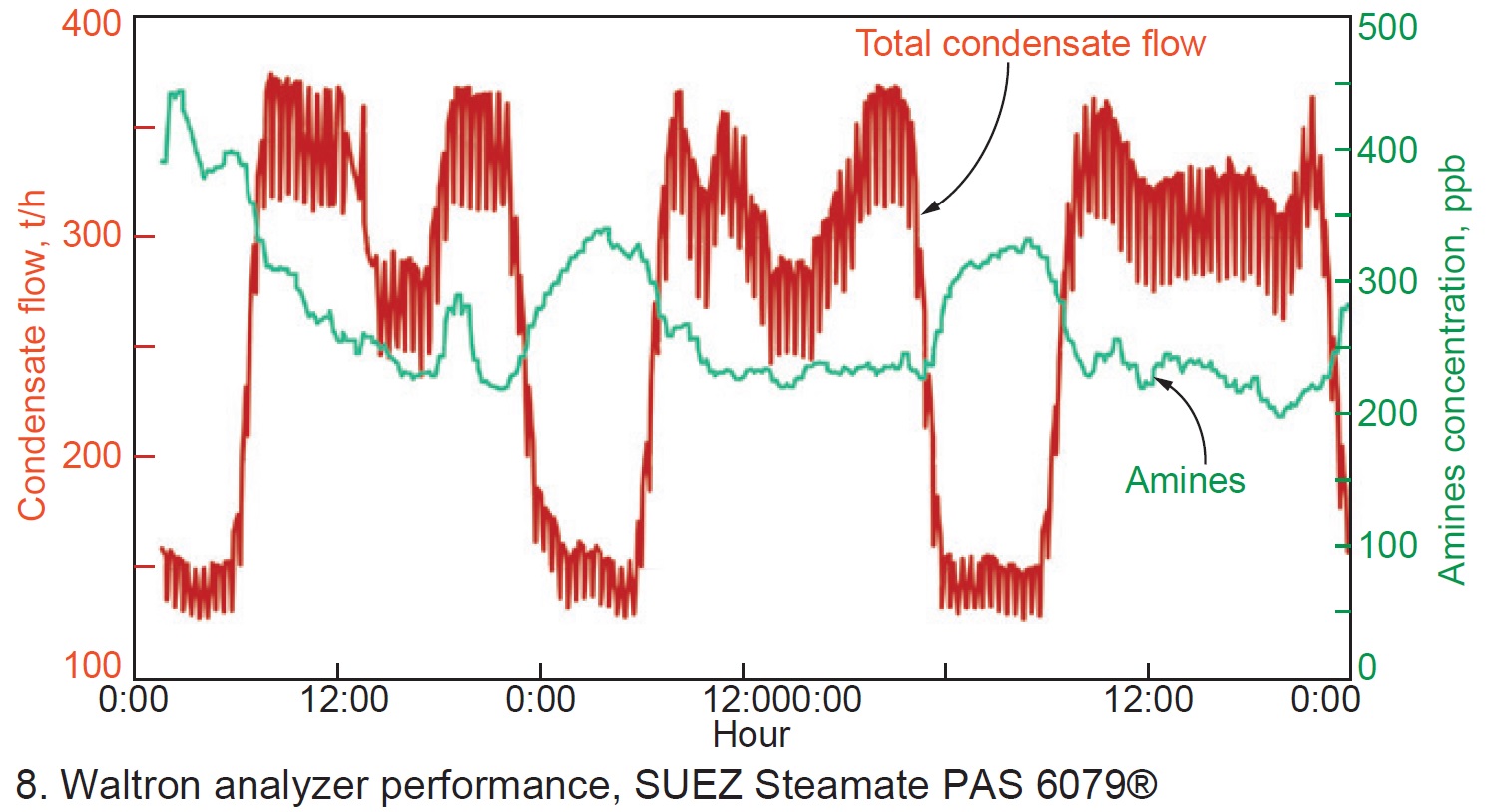
These issues, and proposed solutions, were reviewed. The conclusions: Instruments must be protected, and improved, because FFS have an important place in water and steam chemistry programs. Research is ongoing.
Baseline, due diligence
As a prelude to planning the use of any FFS, a proper baseline is critical. As stated in IAPWS TGD8-16(2019) p 7, “If plants have not previously made thorough assessments of the chemistry used, the consequences of using an FFS cannot be clearly demonstrated.”
Co-chair Addison stressed attention to detail. “Good planning is absolutely critical,” he emphasized. Failure to do proper due diligence can lead to:
- Suboptimal FFS selection.
- Incorrect application of an FFS.
- Failure to obtain full benefits of an FFS.
- Consequential plant issues including equipment failures.
- Excessive application costs with little or no technical benefit.
The key starting points should always be the IAPWS technical guidance documents, available for download and at no cost. The relevant documents for this discussion are these:
- Instrumentation, TGD2-09(2015).
- Corrosion product sampling, TGD 6-13(2014).
- Steam purity, TGD5-13.
- Film-forming substances for fossil, combined-cycle, and biomass plants, TGD8-16(2019).
- Film-forming substances for industrial facilities, TGD11-19.
Section 8 of TGD8-16(2019) p 18, provides operational guidance for operators/users for the continuous addition of an FFS. Your due diligence should include a review of the following:
- Local regulations and suppliers.
-
- Is the product approved and available in your area?
- How will the product get to you, and are there supply-chain risks?
- Supplier competence and willingness.
-
- Will supplier engage with you technically?
- What are supplier’s technical resources?
- Will supplier support you in testing (coupon bench tests, etc.)?
- Annual cost estimates:
-
- Projected FFS consumption.
- Flexible operation rates (often two to five times greater).
- Dosing required at shutdown.
- Your plan versus what others are doing.
- Robust residual analysis methods: Do they work? (bench tests and online analyzers).
- Does the selection impose any technical/commercial/legal restrictions to your site?
- Can you discuss experiences with others one-on-one or at technical conferences?
- Can you use third-party experts for support?
Many of these concerns were highlighted in the final discussions section of the conference.
Path to needed research
The wide range of FFS products, mixtures, and suppliers make research and common solutions difficult. Much of the current industry work is on metal surfaces rather than the oxide surfaces that form within plants. Fundamental research targets are:
- Effect of FFS on growth mechanisms of iron, copper and chromium oxides in water and steam.
- Effect of FFS on boiler and HRSG tube failures (under-deposit corrosion, corrosion fatigue) and stress corrosion cracking.
- Film formation, kinetics, structure and porosity of water- and steam-touched oxide surfaces, to include changes of FFS.
- Uncertainty of thermal degradation, stability limits, and decomposition products for FFA—and especially FFP—under oxidizing and reducing conditions.
- Uncertainty of adsorption onto oxide surfaces for all FFS (FFA, and especially FFP).
- Protection of superheated-steam surfaces with all FFS (FFA, and especially FFP).
- There is evidence of increased steam-turbine performance for amine-based FFS (ODA), but what about other FFAs and FFPs?
Upcoming conferences
The research needs for film-forming substances are a major topic for the next IAPWS Annual Meeting, Nov 27 to Dec 2, 2022, in Rotorua, New Zealand. Dooley serves as executive secretary for IAPWS, David Addison as chairman of the IAPWS Power Cycle Chemistry Working Group.
Mark your calendar: The Sixth IAPWS FFS International Conference will be held Mar 21 – 23, 2023 at Monash University, in Prato, Italy. Details and registration now available at www.filmformingsubstances.com.
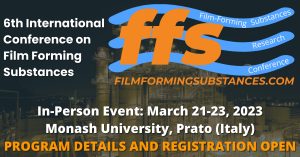 |
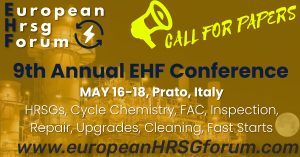 |
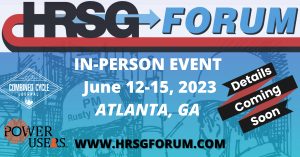 |
The HRSG Forum, led by Co-chairs Bob Anderson of Competitive Power Resources and Barry Dooley of Structural Integrity Associates, continued its tradition of offering excellent user-driven content in its recent virtual meetings. You can dig deeper by accessing the recordings at https://HRSGforum.com. The HRSG Forum in-person meeting, in collaboration with Power Users for the first time, is scheduled for Atlanta the week of June 12. Details coming soon.
The two user-driven presentations during the eighth virtual HRSG Forum (Apr 5, 2022) took deep dives into issues plaguing combined cycles with high transient operating hours: Drain-line and bypass-piping cracking. The first confirmed yet again that lab metallurgical analysis of failed components is a must, even if it adds a day or two to an outage, while the second revealed the growing importance of data mining in failure assessment.
Albert Olszewski, Constellation Energy Generation, titled his presentation “Why Failure Analysis Is Performed,” and the implicit “answer” is, to avoid repeat cracking failures of the same component in the same location. Olszewski’s initial slides showed three crack failures (Fig 3) over a year’s operation of a 2-in., P22, wye-block fitting with a full-penetration weld on an HP evaporator drain line to the blowdown tank. After each discovery, the crack was excavated and weld-repaired by the plant without engineering being involved.
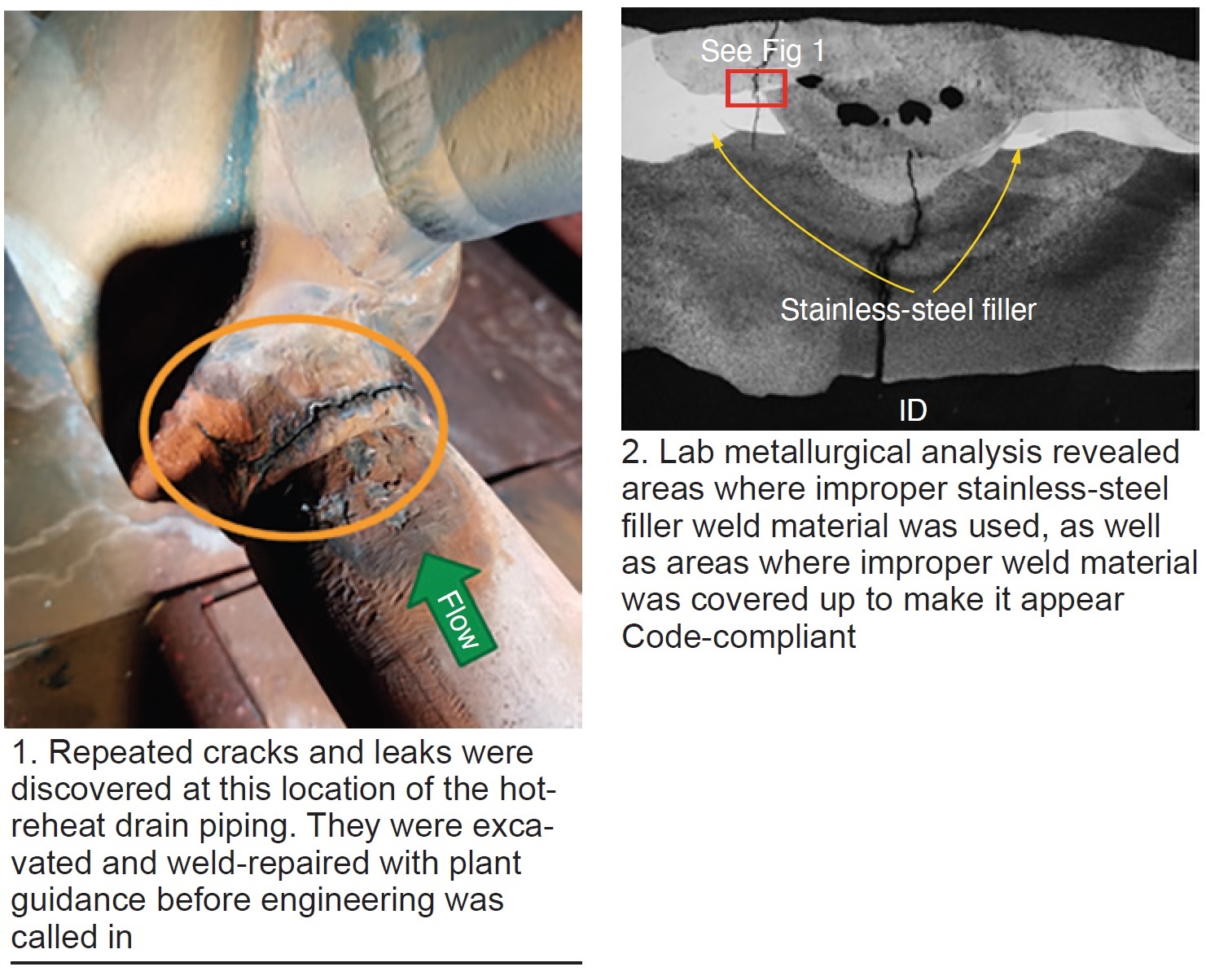
Then the plant replaced the wye-block, only to experience a “terrible crack” right through the weld within a year and a half of operation. Engineering finally was called in. Metallurgical analysis (Fig 4) revealed improper stainless-steel filler material in the field weld, probably from a welder grabbing the wrong filler rod during construction. Remnants of improper weld filler material used since construction seemed to explain the repeated leaks and how often they occurred.
During the post-preso discussion, HRSG Forum Co-chairman Bob Anderson re-iterated that best practice is to always take a sample to the lab for analysis when failures like this one occur. However, he added, such decisions that extend forced-outage durations rarely are taken unless senior management has agreed pre-failure that this is a best practice.
The Q&A was a veritable brainstorming session about other factors which could affect this type of cracking (for example, pipe movement and inadequate supports), ways to obtain additional data (for example, add thermocouples to measure transients), etc—so best to listen to Olszewski’s recording at https://HRSGforum.com. Some experts cautioned that the stainless-steel filler may not be the root cause of the crack.
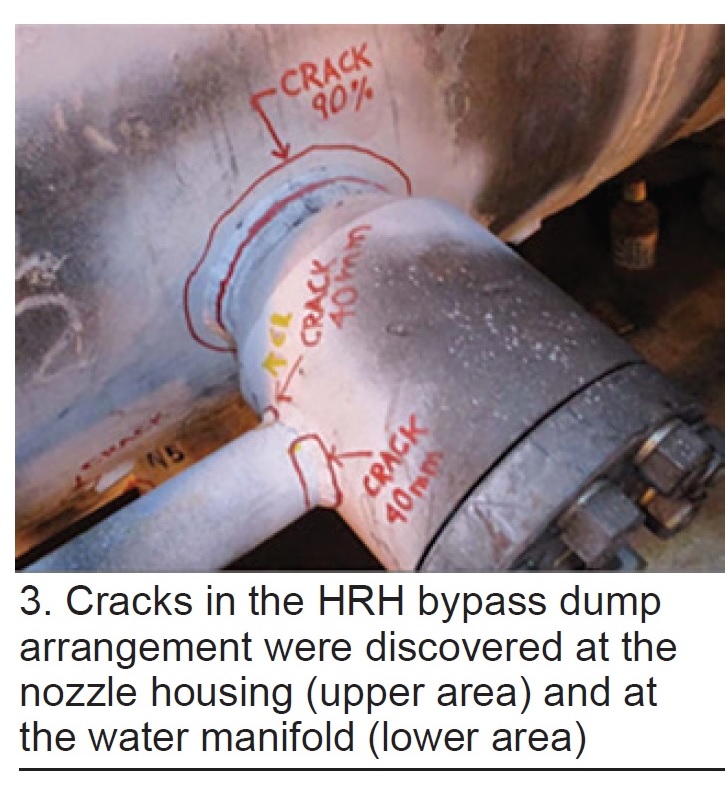 Most everyone knows that data mining permeates our work and personal lives, but it’s refreshing to see it laser-focused on a specific plant problem common to many combined cycles. Diederic Godin, senior manager, Mechanical and Optimization, at Capital Power, and Valve Doctor Ory Selzer, application engineering manager at IMI-CCI, tag-teamed, with Godin setting the context of the plant design and the failed component, while Selzer focused on analyzing the operating data and details of an improved component design.
Most everyone knows that data mining permeates our work and personal lives, but it’s refreshing to see it laser-focused on a specific plant problem common to many combined cycles. Diederic Godin, senior manager, Mechanical and Optimization, at Capital Power, and Valve Doctor Ory Selzer, application engineering manager at IMI-CCI, tag-teamed, with Godin setting the context of the plant design and the failed component, while Selzer focused on analyzing the operating data and details of an improved component design.
Capital Power acquired its Goreway plant in Ontario, in 2019, about a decade after it went commercial. The failure involved a two-stage, low-noise, hot-reheat (HRH) dump valve system to the air-cooled condenser (ACC)—including a 16 × 24 in. steam pressure-control valve with desuperheater, a 24 × 34 in. second-stage desuperheater, and a 34-in. low-noise resistor ahead of the ACC.
The end plate cap from the first-stage desuperheater also was found liberated, with no evidence in the process data that it was missing. The desuperheater thermal liner posed problems early in life, apparently, and was removed after only a few years of operation under the previous owners.
The external water manifold and nozzle housing are in one “spool.” Cracks were discovered at the nozzle housing to steam-pipe connections and in the manifold (Fig 5). Capital decided to replace the valve and desuperheater with an improved design. But once the upgraded outer pipe spool, nozzles, and manifold for a new desuperheater were purchased, internal erosion damage was discovered on the diffuser, so the upgraded design included a new diffuser. The final unit was being installed literally as Godin was making his presentation.
Selzer then turned to the root-cause analysis. IMI Insyt, with specialized data mining techniques, acquired four weeks of operating data in small intervals representing 28 startups across three units, or 25-million data points total. In other words, not an analysis you’d want to attempt using Excel spreadsheets. The startup data important to this component were then overlaid to detect patterns and anomalies.
The “big catch” was a massive quench down to saturation taking place at the desuperheater first stage during each hot start after the bypass (dump) valve opens, a quench that should be taking place at the second stage. This was occurring because of a 500-deg-C minimum superheat override setpoint in the DCS logic (Fig 4). Several other “critical findings” also fell out of the analysis. But you’ll have to get them from the video tape at https://HRSGforum.com. They provide the hardware design modifications and control logic revisions.
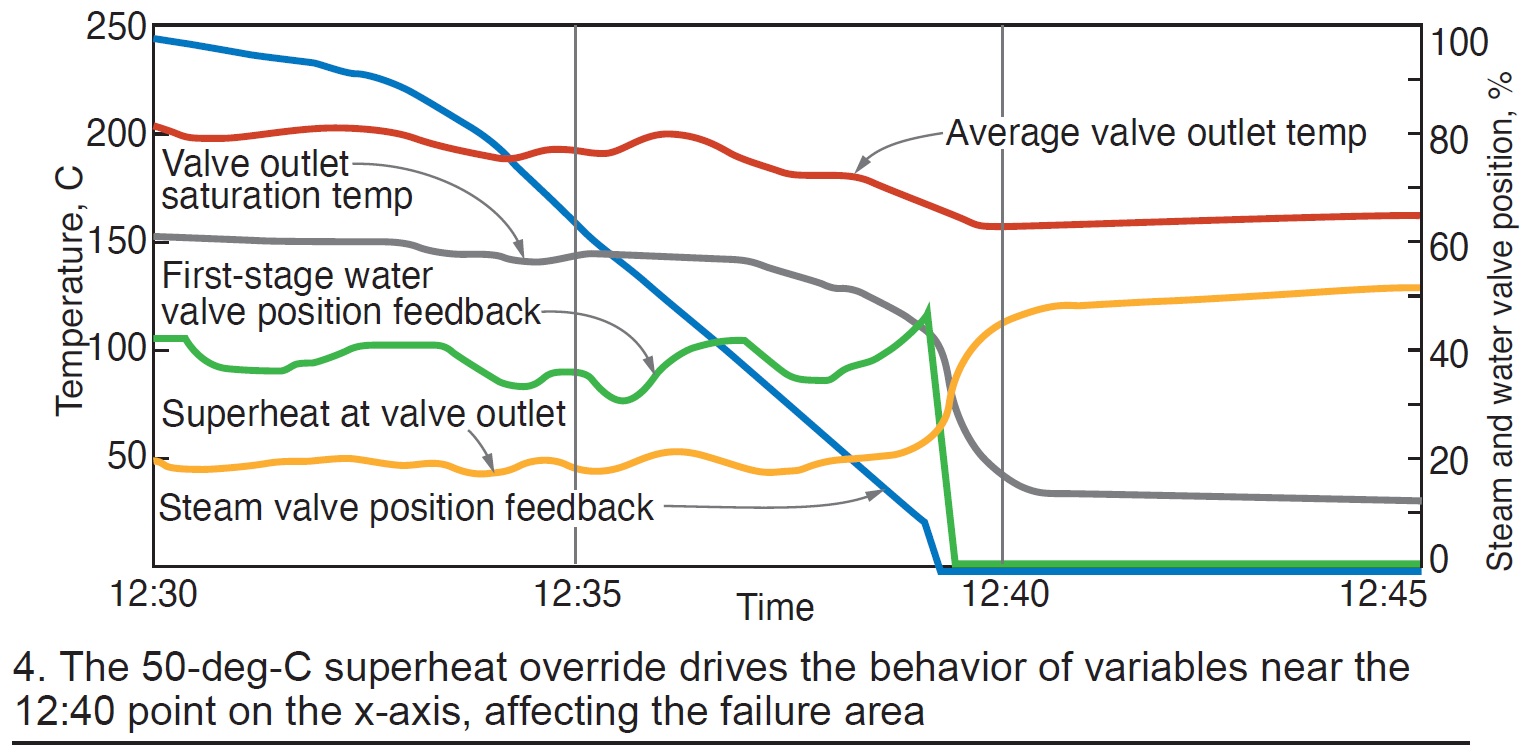
Attendees wondered where the end cap was found (just upstream of the ACC) and whether there were any operating “symptoms” suggesting that it was missing (none). Another in the audience suggested that the plant should have seen a change in pressure drop when the end plate was lost. In response to another inquiry, Godin noted that a sample of the liberated end cap was not taken for analysis.
Barry Dooley, who shares moderating duties with Anderson for these forums, asked if the failed component was analyzed metallurgically and the answer was “no.” He then added that reheaters 1 and 2 are typically constructed of T23, one of the worst materials for exfoliation. Godin responded that he would “dig into this.”
Upcoming HRSG Events
 |
 |
 |
The HRSG Forum, led by Co-chairs Bob Anderson of Competitive Power Resources and Barry Dooley of Structural Integrity Associates, continued its tradition of offering excellent user-driven content in its recent virtual meetings. The HRSG Forum in-person meeting, in collaboration with Power Users for the first time, is scheduled for Atlanta the week of June 12. Details coming soon.
Steve Bates and Steve Harvey shared the details of a catastrophic incident at the 2 × 1 501G-powered Wise County (Tex) Power Plant in which natural gas accumulated in the condenser during an extended outage and exploded when a welder attempted to repair an external pipe. In the opinion of the editors this presentation could be one of the most valuable safety briefs you’ll receive if you have a combined-cycle plant with a fuel gas heater (FGH). An abridged account follows.
As a result of a failure of a main lead in the steam turbine/generator, the facility was in a steam-turbine outage in January 2022 during which the Wise County GTs remained “available” to the grid (with fuel at pressure up to the FGH stop valves). With the plant experiencing numerous issues with the FGH (for example, leaking gas isolation valves) and its leak detection system (prone to false alarms), and other factors, natural gas found its way to the condenser through the IP water-side supply line (the source of heat for the FGH).
The plant was down for 10 days, but with cold weather in the forecast, the gas turbines were started to build up pressure to about 50 psig in the HRSG to prevent freezing. The steam pressure in the HRSG provided the motive force to move the gas that had been accumulating in the IP drum to flow down the steam piping to the condenser.
When a welder arrived to repair a 1-in. pipe connection on the outside of the condenser, the arc ignited the gas and the subsequent explosion blew out six rupture discs on top of the unit, caused bolting threads on the LP steam-turbine cover to fail, and damaged internal structural supports. Rupture-disc parts were found all over the plant site. The explosion was heard and felt throughout the plant.
Mercifully, no one was injured (not even the welder), no condenser tube leaks resulted, and the LP section of the turbine suffered no internal damage.
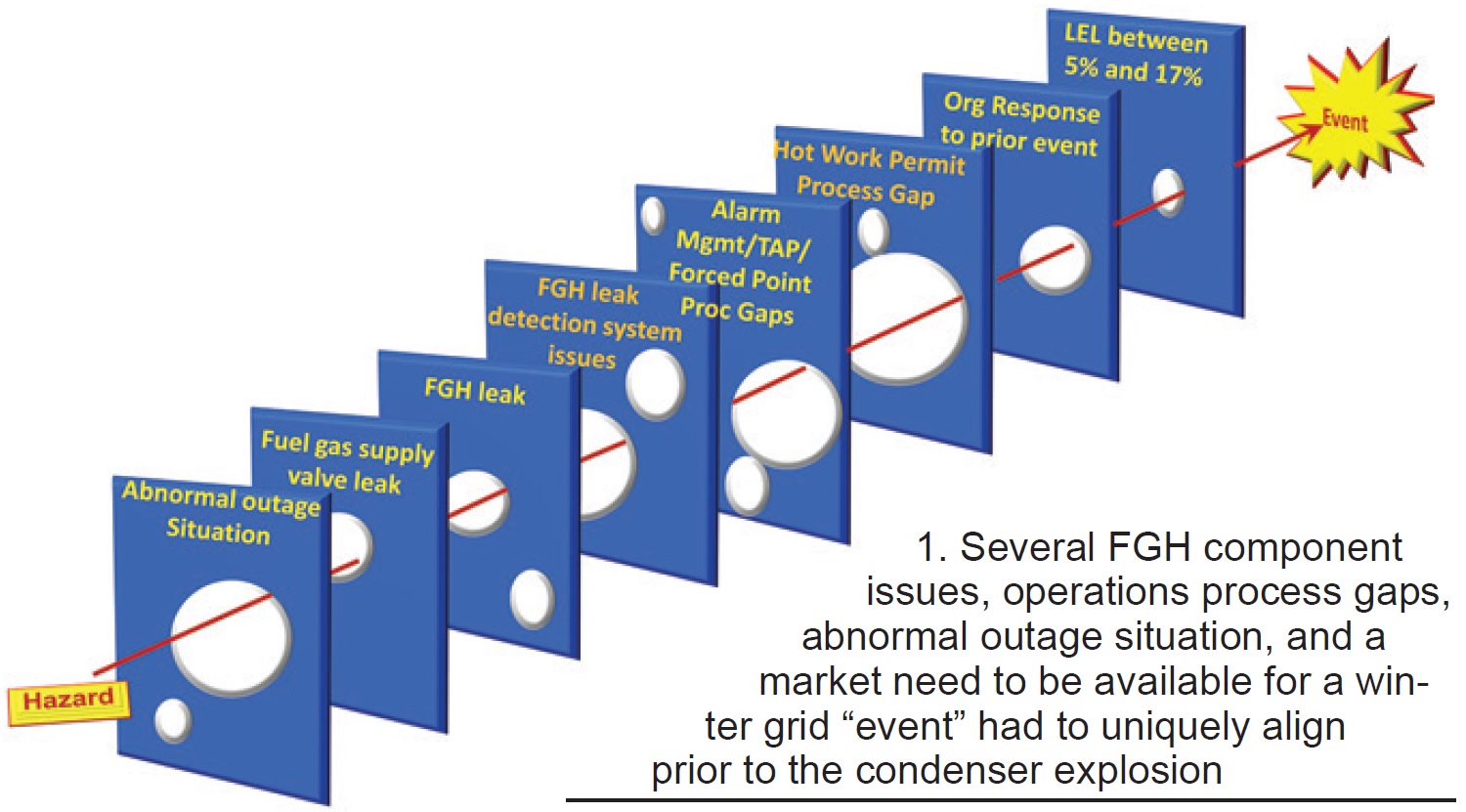
Bates covered the events (Fig 1) at the plant which had to uniquely align for this incident to even be possible, as well as his company’s fleet-wide assessment and recommendations to avoid a similar incident elsewhere, including the following:
- Eddy current test FGH tube bundles and perform leaking testing at least every six years.
- Utilize more robust inserts when plugging tubes.
- Ease plant staff access to vent valving and instrumentation.
- Establish fleet standard critical preventive maintenance guidelines for FGH systems.
- Perform comprehensive FGH system design review.
- Install permanent redundant methane detectors on air ejectors with feedback to control system.
This presentation is not available online. Those interested in learning more should contact Bates directly.
Upcoming HRSG Events
 |
 |
 |


